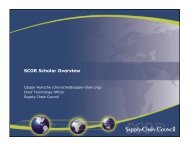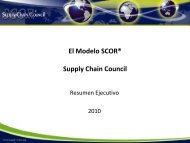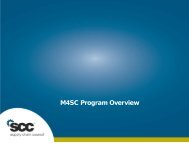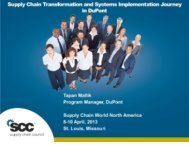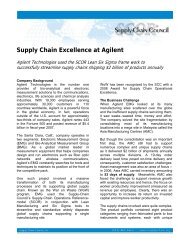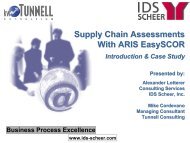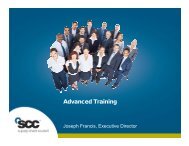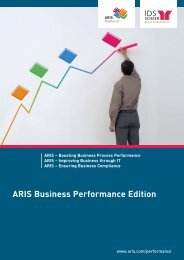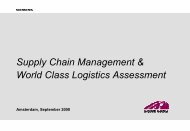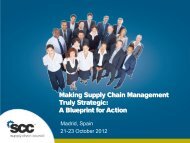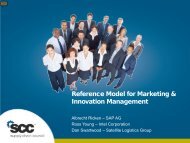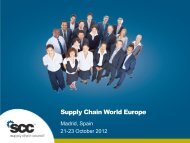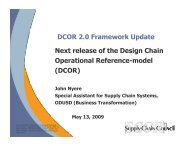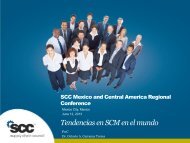2010 SCC Engen Executive.pdf - Supply Chain Council
2010 SCC Engen Executive.pdf - Supply Chain Council
2010 SCC Engen Executive.pdf - Supply Chain Council
You also want an ePaper? Increase the reach of your titles
YUMPU automatically turns print PDFs into web optimized ePapers that Google loves.
<strong>SCC</strong> & SCOR Overview<strong>Engen</strong>© <strong>2010</strong> <strong>Supply</strong> <strong>Chain</strong> <strong>Council</strong>. ALL RIGHTS RESERVED. | <strong>2010</strong> <strong>Engen</strong> <strong>Executive</strong> | 1 | 25 July <strong>2010</strong>Joseph Francis, <strong>Executive</strong> Director <strong>SCC</strong>
A Bit of History: 1930-1950• Bank Robber “SlickWillie” Sutton• When asked why herobbed banks, Suttonsimply replied• "Because that'swhere the money is."© <strong>2010</strong> <strong>Supply</strong> <strong>Chain</strong> <strong>Council</strong>. ALL RIGHTS RESERVED. | <strong>2010</strong> <strong>Engen</strong> <strong>Executive</strong> | 4 | 25 July <strong>2010</strong>
<strong>Supply</strong> <strong>Chain</strong> is Dominant Company Cost Driver• In 2007, US business logistics costs rose toan all time high of $1.4 trillion (10.1% of USnominal Gross Domestic Product ) 3• <strong>Supply</strong>‐chain generally accounts forbetween 60% and 90% of all companycosts 1• A 2% improvement in process efficiency forsupply‐chain processes has 3000% ‐ 5000%the impact of a 2% improvement inefficiency i for… IT… HR… Finance 1 … Sl Sales…Fortune-10 Company<strong>Supply</strong>-<strong>Chain</strong> Cost as% of Total Costs 2GM 94%Ford 93%Conoco 90%Wal-Mart 90%Chevron 88%IBM 77%Exxon 75%GE 63%Citi 1 0%AIG 1 0%1 Exclusive of Financial Services companies2 Source: Hoovers 2006 Financial Data, <strong>Supply</strong>-<strong>Chain</strong> <strong>Council</strong> 2006 SCMBenchmark data on SCM cost for discrete & process industries3 CSCMP 19 th Annual State of the Logistics Industry© <strong>2010</strong> <strong>Supply</strong> <strong>Chain</strong> <strong>Council</strong>. ALL RIGHTS RESERVED. | <strong>2010</strong> <strong>Engen</strong> <strong>Executive</strong> | 5 | 25 July <strong>2010</strong>
Value Differential: 2:1 Margin Advantage% of Reve enueSource: PRTM/The Performance Measurement Group© <strong>2010</strong> <strong>Supply</strong> <strong>Chain</strong> <strong>Council</strong>. ALL RIGHTS RESERVED. | <strong>2010</strong> <strong>Engen</strong> <strong>Executive</strong> | 6 | 25 July <strong>2010</strong>
<strong>Supply</strong> <strong>Chain</strong> is Directly Connected to Company ValueThe <strong>Supply</strong> <strong>Chain</strong> Impacts .. .• Improve customer service andresponse• Optimize inventory flow,utilization & productivityThe Knobs &LeversRevenueProfit& ShareholderValue• Best-in-class customerrelationships• Differentiated servicecapabilities• Best-in-class strategic supplierpartnerships• Leverage of outsourcing ofbusiness processes• Unique supply chain modelsExpenseWorkingCapitalFixed CapitalCapitalEfficiencyValue© <strong>2010</strong> <strong>Supply</strong> <strong>Chain</strong> <strong>Council</strong>. ALL RIGHTS RESERVED. | <strong>2010</strong> <strong>Engen</strong> <strong>Executive</strong> | 8 | 25 July <strong>2010</strong>
<strong>SCC</strong>: An independent, non-profit global association• Formed in 1996 to create and evolve a standard industry processreference model of the supply chain for the benefit of helping companiesrapidly and dramatically improve supply ppy chain operations• <strong>SCC</strong> has established the supply chain world’s most widely acceptedframework – the SCOR® process reference model – for evaluating andcomparing supply chain activities and their performance› It can be used to describe supply chains that are very simple or verycomplex using a common set of definitions and enabling a commonunderstanding› It lets companies quickly determine and compare the performance ofsupply chain and related operations within their company or againstother companies• <strong>SCC</strong> continually advances its tools and educates members about howcompanies are capitalizing on those tools› With membership open to all interested organizations© <strong>2010</strong> <strong>Supply</strong> <strong>Chain</strong> <strong>Council</strong>. ALL RIGHTS RESERVED. | <strong>2010</strong> <strong>Engen</strong> <strong>Executive</strong> | 9 | 25 July <strong>2010</strong>
Global Scope With Over 800 Member OrganizationsMember DistributionNorthAmericaAustralia/New ZealandChinaSouth AfricaLatinAmericaSoutheastAsiaJapanMember AffiliationEuropeGovernmentSMEEnd UserEnabling TechnologyAlso developing chapters inIndia and the Middle EastConsultantNon-Profit/Academic0% 10% 20% 30% 40% 50%© <strong>2010</strong> <strong>Supply</strong> <strong>Chain</strong> <strong>Council</strong>. ALL RIGHTS RESERVED. | <strong>2010</strong> <strong>Engen</strong> <strong>Executive</strong> | 10 | 25 July <strong>2010</strong>
SCM Asset Returns: Superior Valuation• Comparison of Fortune‐1000 <strong>Council</strong>member company share price aggregategrowth from 2003 – present to S&P 500and DOW indices.• Growth inflected after 2 years, and thespread between SCOR index companies andother industrials has grown to almost 30points.• Growth is increasing exponentially:Compound interest on SC performance.• Correlates <strong>SCC</strong> Membership/SCORinvestments with Shareholder value.• Same pattern evident in FTSE‐100, DAX,NIKKEI and other indices.© <strong>2010</strong> <strong>Supply</strong> <strong>Chain</strong> <strong>Council</strong>. ALL RIGHTS RESERVED. | <strong>2010</strong> <strong>Engen</strong> <strong>Executive</strong> | 12 | 25 July <strong>2010</strong>
<strong>SCC</strong> membership accelerates a company’s use of –andbenefits from – SCOR and related modelsReference models,benchmarking, toolsresearch and help fromSCOR expertsTraining, certification,career development andvolunteer opportunitiesChapters, events andforums to share SCOR andsupply chain knowledgeand experience© <strong>2010</strong> <strong>Supply</strong> <strong>Chain</strong> <strong>Council</strong>. ALL RIGHTS RESERVED. | <strong>2010</strong> <strong>Engen</strong> <strong>Executive</strong> | 13 | 25 July <strong>2010</strong>
Member benefits – Unlimited Employee Access toResourcesSCORRelatedFrameworksSCORmarkResearchToolsPublicationsExpertNetworkA supply chain process reference modelcontaining over 200 process elements, 550metrics, 500 best practices, and 200 skillsclassifications including risk and environmentalmanagementAdditional process reference models such asCCOR (customer chain) and DCOR (designBenchmarking chain) of supply chain performance against industry peersOngoing research on supply chain processes, practices, metricsand skills both globally and by industry and geographic regionTemplates, website, software and methods developed andcontributed by volunteer <strong>SCC</strong> working groups as well academicsand third party providersCase studies, articles, conference proceedings and newslettersAccess to staff, trainers and advisors to coach individuals andteams in use of SCOR© <strong>2010</strong> <strong>Supply</strong> <strong>Chain</strong> <strong>Council</strong>. ALL RIGHTS RESERVED. | <strong>2010</strong> <strong>Engen</strong> <strong>Executive</strong> | 14 | 25 July <strong>2010</strong>
Member benefits – Individual Capability DevelopmentTrainingCertificationVolunteeringCareerDevelopmentPublic and in-house training courses onthe SCOR framework, its implementation,CCOR and DCOR models and moreIndividual Employee SCOR Professionalcertification on understanding of, andability to use, the SCOR model as well asSCOR Academic certification for thoseentering the workforce from schoolParticipation on numerous committees andworking ggroups to develop new models,tools and practices in supply chainmanagementSkills identification, career pathidentification, online job postings ofpositions requiring SCOR knowledge, andin-person member networkingopportunities© <strong>2010</strong> <strong>Supply</strong> <strong>Chain</strong> <strong>Council</strong>. ALL RIGHTS RESERVED. | <strong>2010</strong> <strong>Engen</strong> <strong>Executive</strong> | 15 | 25 July <strong>2010</strong>
Member benefits – Knowledge NetworksChaptersEventsForumsChapter meetings, networks and materialsin local languages discussing supply chainissues of greatest regional interestFrequent webinars (over 80 archived formembers) and annual regional conferencessuch as <strong>Supply</strong>-<strong>Chain</strong> WorldVirtual and in-person discussion forums fornetworking and problem-solving amongcommunities of common interest (such asindustry special interest groups)© <strong>2010</strong> <strong>Supply</strong> <strong>Chain</strong> <strong>Council</strong>. ALL RIGHTS RESERVED. | <strong>2010</strong> <strong>Engen</strong> <strong>Executive</strong> | 16 | 25 July <strong>2010</strong>
OIL & GAS WORKING GROUP© <strong>2010</strong> <strong>Supply</strong> <strong>Chain</strong> <strong>Council</strong>. ALL RIGHTS RESERVED. | <strong>2010</strong> <strong>Engen</strong> <strong>Executive</strong> | 17 | 25 July <strong>2010</strong>
<strong>SCC</strong> Energy, Oil & Gas Industry Group HistoryWhy we chose to create Industry Group?• Energy, Oil & Gas Resources are critical business and personal topics that are on the top of mind• E, O & G <strong>Supply</strong> <strong>Chain</strong>s are:– Unique (Capital Projects (ETO), Operations (process), EAM)– Have limited benchmark data– Still very focused on Procurement (Source)• Create a Oil and Gas <strong>Supply</strong> <strong>Chain</strong> Process Model to enable industry chain benchmarking andbest practice implementationWhat has happened so far?• Energy, Oil and Gas Industry Group formed and kicked off December 2007• Teams were formed to address process models and benchmarking, but realized a common highlevel model was required to move forward• The team created a high level Oil & Gas Industry Segment Definition• Teams have been created and developing strategies and metrics for top oil & gas supply chains© <strong>2010</strong> <strong>Supply</strong> <strong>Chain</strong> <strong>Council</strong>. ALL RIGHTS RESERVED. | <strong>2010</strong> <strong>Engen</strong> <strong>Executive</strong> | 18 | 25 July <strong>2010</strong>
SCM Competitive Advantage% of Reve enueBest-in-class Companies’ Outperform Their Median Competitors with a50% Cost AdvantageSource: PRTM/The Performance Measurement Group© <strong>2010</strong> <strong>Supply</strong> <strong>Chain</strong> <strong>Council</strong>. ALL RIGHTS RESERVED. | <strong>2010</strong> <strong>Engen</strong> <strong>Executive</strong> | 19 | 25 July <strong>2010</strong>
But SCM is Paramount in Times of Economic UncertaintyFortune-10 Company<strong>Supply</strong>-<strong>Chain</strong> Cost as% of Total Costs 2• In 2007, US business logistics costs rose to an alltime high of $1.4 trillion (10.1% of US nominalGross Domestic Product )3GM 94%•Ford 93%<strong>Supply</strong>‐chain generally accounts for between 60%and 90% of all company costs 1 Conoco 90%• A 2% improvement in process efficiency for supplychainprocesses has 3000% ‐ 5000% the impact of a2% improvement in efficiency for… IT… HR…Finance 1 … Sales…1 Exclusive of Financial Services companies2 Source: Hoovers 2006 Financial Data, <strong>Supply</strong>-<strong>Chain</strong> <strong>Council</strong> 2006 SCMBenchmark data on SCM cost for discrete & process industries3 CSCMP 19 th Annual State of the Logistics IndustryWal-Mart 90%Chevron 88%IBM 77%Exxon 75%GE 63%Citi 1 0%AIG 1 0%Focused initiatives in <strong>Supply</strong> <strong>Chain</strong> Management can result in 30-35% costreductions, liberation of working capital, and revenue increases of 3-5%!© <strong>2010</strong> <strong>Supply</strong> <strong>Chain</strong> <strong>Council</strong>. ALL RIGHTS RESERVED. | <strong>2010</strong> <strong>Engen</strong> <strong>Executive</strong> | 20 | 25 July <strong>2010</strong>
Oil & Gas Challenge: Application of SCOR• How to facilitate and accelerate improvementsin Oil & Gas <strong>Supply</strong> <strong>Chain</strong>s› Completeness: enough reference data to address common Oil &Gas metrics and processes› Benchmark: Provide a neutral metrics framework for broadindustry benchmarking of supply chains› Practices: What are industry-specific best practices can beadded to the SCOR framework› Strategy: Common industry strategies by Oil & Gas supply chaintype› Flows: what do material flows look like for Oil & Gas, and how dothey relate to metrics© <strong>2010</strong> <strong>Supply</strong> <strong>Chain</strong> <strong>Council</strong>. ALL RIGHTS RESERVED. | <strong>2010</strong> <strong>Engen</strong> <strong>Executive</strong> | 21 | 25 July <strong>2010</strong>
Working Group Tasks• To Date› Understand Scope and Extent of Oil & Gas <strong>Supply</strong> ppy <strong>Chain</strong>› Identify major supply chain types within business segments› Identify major supply chain strategies› Create base of reference SCORcards for benchmarking› Facilitate industry benchmarking process• Near future:› Create base of reference material flows› Create base of reference best practices related to identifiedsupply chains› Educate on and disseminate findings© <strong>2010</strong> <strong>Supply</strong> <strong>Chain</strong> <strong>Council</strong>. ALL RIGHTS RESERVED. | <strong>2010</strong> <strong>Engen</strong> <strong>Executive</strong> | 22 | 25 July <strong>2010</strong>
Defined The Scope of Energy Oil & Gas• Initial focus on Upstream, Midstream, and Downstream with articulation of some details of the material flow.• Identified Infrastructure Equipment & Maintenance as common area to all three.© <strong>2010</strong> <strong>Supply</strong> <strong>Chain</strong> <strong>Council</strong>. ALL RIGHTS RESERVED. | <strong>2010</strong> <strong>Engen</strong> <strong>Executive</strong> | 23 | 25 July <strong>2010</strong>
Framework for Benchmarking• <strong>Supply</strong> <strong>Chain</strong> Definition• <strong>Supply</strong> <strong>Chain</strong> Prioritization• <strong>Supply</strong> <strong>Chain</strong> Strategy• Selecting Metrics• Sourcing Data• Creating a Balanced SCORcard• Performing Benchmark© <strong>2010</strong> <strong>Supply</strong> <strong>Chain</strong> <strong>Council</strong>. ALL RIGHTS RESERVED. | <strong>2010</strong> <strong>Engen</strong> <strong>Executive</strong> | 24 | 25 July <strong>2010</strong>
<strong>Supply</strong> <strong>Chain</strong> Definition• <strong>Supply</strong> <strong>Chain</strong>s are the Totality of processes spanningoperations from supplier to end-customer, focused onmaterial, work and information flow• We use a tool called the <strong>Supply</strong> <strong>Chain</strong> Definition Matrixto define the <strong>Supply</strong> <strong>Chain</strong>s within an enterprise• The <strong>Supply</strong> <strong>Chain</strong> Definition (i/o Matrix) Matrix helpsdetermine the number and size of supply chains• Columns: Customers (Output)• Rows: Products (Input)• The intersection of each column and row – if the goodsor services flow to the customer – is a supply chain© <strong>2010</strong> <strong>Supply</strong> <strong>Chain</strong> <strong>Council</strong>. ALL RIGHTS RESERVED. | <strong>2010</strong> <strong>Engen</strong> <strong>Executive</strong> | 25 | 25 July <strong>2010</strong>
Downstream <strong>Supply</strong> <strong>Chain</strong> DefinitionOil and Gas IndustryDownstream<strong>Supply</strong>-<strong>Chain</strong> Definition MatrixDirectConsumerCustomers/Markets/ChannelsCommercialBulkGovermental/Public SectorBy‐Product orInputLink SelectionsIndustrial Tag <strong>Supply</strong>-<strong>Chain</strong> NameClear LinksLube Oil X X X X11 Consumer GasolineTransportation nGasoline X X X 2 Industrial Natural GasDiesel X X X 3 Commercial DieselAviation Fuel X X X 4 Commercial Aviation Fuels ‐sLines of BusinessProduct FamiliesNatural Gas X X X 5 Commercial Base ChemicalsSulfur X 6 Consumer Lube OilPetroleum Coke X 7 Commercial Specialty ChemicalsSpecialty Chemical X X 8 Industrial Specialty ChemicalHeating Oil X X 9 Industrial Lube OilBase Chemicals(Polymers)X X 10 Commercial Lube OilWaxes X X XUsing a supply chain identificationAsphalt X X X matrix, created master high‐levellist of supply chains withinDownstream© <strong>2010</strong> <strong>Supply</strong> <strong>Chain</strong> <strong>Council</strong>. ALL RIGHTS RESERVED. | <strong>2010</strong> <strong>Engen</strong> <strong>Executive</strong> | 26 | 25 July <strong>2010</strong>
Downstream <strong>Supply</strong> <strong>Chain</strong> PrioritizationOil and Gas IndustryDownstream<strong>Supply</strong> <strong>Chain</strong>s taken fromthe Definition Matrix<strong>Supply</strong> <strong>Chain</strong> Priority MatrixWhen assigning rank; the highest number should correspond to the highest rank. The supply chain with the highestoverall rating takes the biggest priority.CriteriaGross Margin %Unit VolumeNANANAWeight100% 100%0%0%0%Overall Rank Result Rank Result Rank Result Rank Result Rank ResultConsumer Gasoline 1 1 1 0 0 0 0Industrial Natural Gas 2 2 2 0 0 0 0Commercial Diesel 3 3 3 0 0 0 0Commercial Aviation Fuel 4 4 4 0 0 0 0Commercial Base Chemicals 5 5 5 0 0 0 0Consumer Lube Oil 6 6 6 0 0 0 0Commercial SpecialtyChemicals1 0 1 1 0 0 0Industrial Specialty Chemical 2 0 2 2 0 0 0Industrial Lube Oil 3 0 3 3 0 0 0Commercial Lube Oil 4 0 4 4 0 0 0Light Prioritization for further assessments© <strong>2010</strong> <strong>Supply</strong> <strong>Chain</strong> <strong>Council</strong>. ALL RIGHTS RESERVED. | <strong>2010</strong> <strong>Engen</strong> <strong>Executive</strong> | 27 | 25 July <strong>2010</strong>
<strong>Supply</strong> <strong>Chain</strong> StrategyReliabilityResponsivenessOn time? Complete? Undamaged?From Customer Request to final acceptanceFlexibilityHow long to scale up? How expensive e to scaledown?Cost Cost of Processes? Cost of Goods Sold?AssetsWorking Capital? Return on Investments?t • We use a tool called the <strong>Supply</strong> <strong>Chain</strong> StrategyMatrix to Identify priority strategic features orattributes of <strong>Supply</strong> <strong>Chain</strong>s.• Each supply chain strategy is indicated by acollection of ranked features:© <strong>2010</strong> <strong>Supply</strong> <strong>Chain</strong> <strong>Council</strong>. ALL RIGHTS RESERVED. | <strong>2010</strong> <strong>Engen</strong> <strong>Executive</strong> | 28 | 25 July <strong>2010</strong>
Comparative RankingPerformance Percentile Choices InterpretationSuperior 90 th 1 Need to be “Top 10” performerAdvantage 75 th 2 Need to be “Top Half” performerParity 50 th 2 “Half better/Half worse”• We advocate using a simple ranking system forindustry comparison• Each rank corresponds to a specific percentile inindustry performance• We do not use averages or other statistical tests• Our key ranks:© <strong>2010</strong> <strong>Supply</strong> <strong>Chain</strong> <strong>Council</strong>. ALL RIGHTS RESERVED. | <strong>2010</strong> <strong>Engen</strong> <strong>Executive</strong> | 29 | 25 July <strong>2010</strong>
Initial Downstream StrategiesOil and Gas IndustryDownstream <strong>Supply</strong>-<strong>Chain</strong>Strategy MatrixConsumerGasolineIndustrial NaturalGasCommercial DieselCommercialAviation FuelCommercial BaseChemicalsConsumer Lube OilCommercialSpecialtyChemicalsIndustrialCommercialIndustrial Lube OilSpecialty ChemicalLubeOilReliability P P PExternalResponsiveness P A PAgility P S PCost S P SInternalCreate ColumnsAssets A P A• Each unique combination ofratings defines Your <strong>Supply</strong><strong>Chain</strong> Strategy for thechannel• Think of the rating as adesired state, NOT where youwant to improve the most© <strong>2010</strong> <strong>Supply</strong> <strong>Chain</strong> <strong>Council</strong>. ALL RIGHTS RESERVED. | <strong>2010</strong> <strong>Engen</strong> <strong>Executive</strong> | 30 | 25 July <strong>2010</strong>RELIABILITY ‐ The performance of the supply chain in delivering: the correctproduct, to the correct place, at the correct time, in the correct condition andpackaging, in the correct quantity, with the correct documentation, to thecorrect customer.RESPONSIVENESS ‐ The speed at which a supply chain provides products to thecustomer.AGILITY ‐ The agility of a supply chain in responding to marketplace changes togain or maintain competitive advantage.COST ‐ The costs associated with operating the supply chain.ASSETS ‐ The effectiveness of an organization in managing assets to supportdemand satisfaction. This includes the management of all assets: fixed andworking capital.
Initial SCORcard Created (Consumer Gasoline)© <strong>2010</strong> <strong>Supply</strong> <strong>Chain</strong> <strong>Council</strong>. ALL RIGHTS RESERVED. | <strong>2010</strong> <strong>Engen</strong> <strong>Executive</strong> | 31 | 25 July <strong>2010</strong>
Final Benchmarking Phase• Used for choosing target performance• Critical to understand Performance in a particularDemographic• Can be “internal” (competing against other supply chainsin same company)• Aligns Strategy, Performance, and Performance GoalsAttribute SAP Metric (level 1) You Parity Adv Superior GapReliability S Perfect Order Fulfillment 97% 92% 95% 98% 1%Response A Order Fulfillment Cycle Time 14 days 8 days 6 days 4 days 8 DaysFlexibility P Ups. <strong>Supply</strong> <strong>Chain</strong> Flexibility 62 days 80 days 60 days 40 days 0Cost P <strong>Supply</strong> <strong>Chain</strong> Mgmt Cost 12.2% 10.8% 10.4% 10.2% 1.4%Assets A Cash‐to‐Cash Cycle Time 35 days 45 days 33 days 20 days 2 Days*Sample Data Only© <strong>2010</strong> <strong>Supply</strong> <strong>Chain</strong> <strong>Council</strong>. ALL RIGHTS RESERVED. | <strong>2010</strong> <strong>Engen</strong> <strong>Executive</strong> | 32 | 25 July <strong>2010</strong>
SCOR OVERVIEW© <strong>2010</strong> <strong>Supply</strong> <strong>Chain</strong> <strong>Council</strong>. ALL RIGHTS RESERVED. | <strong>2010</strong> <strong>Engen</strong> <strong>Executive</strong> | 33 | 25 July <strong>2010</strong>
SCOR: A Process Framework• Process frameworks deliver the well-known concepts of business processreengineering, benchmarking, and best practices into a cross-functionalframework› Standard processes:Plan, Source, Make, Deliver, Return, Enable› Standard metrics:Perfect Delivery, Cash Cycle Time, <strong>Supply</strong>-<strong>Chain</strong> Cost, etc› Standard practicesEDI, CPFR, Cross-Training, etc• Pre-defined relationships between processes, metrics and practices© <strong>2010</strong> <strong>Supply</strong> <strong>Chain</strong> <strong>Council</strong>. ALL RIGHTS RESERVED. | <strong>2010</strong> <strong>Engen</strong> <strong>Executive</strong> | 34 | 25 July <strong>2010</strong>
What is a <strong>Supply</strong> <strong>Chain</strong>?Product/Portfolio ManagementSuppllier proceessesProduct DesignSales & SupportDCORCCOR<strong>Supply</strong> <strong>Chain</strong>SCOR ®Custoomer proccesses© <strong>2010</strong> <strong>Supply</strong> <strong>Chain</strong> <strong>Council</strong>. ALL RIGHTS RESERVED. | <strong>2010</strong> <strong>Engen</strong> <strong>Executive</strong> | 35 | 25 July <strong>2010</strong>
End-to-EndSCOR contains five key management process categoriesof activity which seamless link suppliers, enterprise supply-ppychains, and customersPlanDeliverSourceMakeDeliverSource Make Deliver Source Make DeliverSourceReturn Return ReturnReturnReturnReturnReturnReturnSuppliers’SupplierSupplierYour CompanyCustomerCustomer’sCustomerInternal or ExternalInternal or ExternalSCOR Model© <strong>2010</strong> <strong>Supply</strong> <strong>Chain</strong> <strong>Council</strong>. ALL RIGHTS RESERVED. | <strong>2010</strong> <strong>Engen</strong> <strong>Executive</strong> | 36 | 25 July <strong>2010</strong>
Measure and BenchmarkAttribute Metric (level 1) Company Parity Adv SuperiorParityGapReqGapReliability Perfect Order Fulfillment 98% 92% 96% 98% -6%minusequalsResponsiveness Order Fulfillment Cycle Time 14 days 8 days 6 days 4 days 6 days 8 daysFlexibility Ups. <strong>Supply</strong> <strong>Chain</strong> Flexibility 62 days 80 days 62 days 40 days -18 daysCost <strong>Supply</strong> <strong>Chain</strong> Mgmt Cost 10.1% 10.8% 10.4% 10.2% -0.7%Assets Cash-to-Cash Cycle Time 22 days 45 days 30 days 20 days -23 daysWe now link strategy, performance,and benchmark to identifyParity Median ofStatistical Sampleperformance _required_ of strategy Advantage 75% percentile ofpopulationSuperior90 th percentile ofpopulation© <strong>2010</strong> <strong>Supply</strong> <strong>Chain</strong> <strong>Council</strong>. ALL RIGHTS RESERVED. | <strong>2010</strong> <strong>Engen</strong> <strong>Executive</strong> | 38 | 25 July <strong>2010</strong>
Best PracticesBest practice: "A current, structured, proven and repeatable method for makinga positive impact on desired operational results. "› CurrentMust not be emerging and can not be antiquated› StructuredHas clearly stated Goal, Scope, Process, and Procedure› ProvenSuccess has been demonstrated in a working environment and canbe linked to key metrics› RepeatableThe practice has been proven in multiple environments.© <strong>2010</strong> <strong>Supply</strong> <strong>Chain</strong> <strong>Council</strong>. ALL RIGHTS RESERVED. | <strong>2010</strong> <strong>Engen</strong> <strong>Executive</strong> | 39 | 25 July <strong>2010</strong>
SCOR HierarchyLevel 1 Level 2 Level 3 Level 4 Level 5Scope Configuration Activity Workflow Transactions<strong>Supply</strong>-<strong>Chain</strong>SourceS1SourceStocked ProductS1.2Receive ProductEDIXMLDifferentiatesBusinessDefines ScopeDifferentiatesComplexityDifferentiatesCapabilitiesNames Tasks Sequences Steps LinksTransactionsLinks, Metrics,Tasks andPracticesJob DetailsDetails ofAutomationtiFrameworkLanguageFrameworkLanguageFrameworkLanguageIndustry orCompanySpecificLanguageTechnologySpecificLanguageStandard SCOR definitionsCompany/Industry definitions© <strong>2010</strong> <strong>Supply</strong> <strong>Chain</strong> <strong>Council</strong>. ALL RIGHTS RESERVED. | <strong>2010</strong> <strong>Engen</strong> <strong>Executive</strong> | 40 | 25 July <strong>2010</strong>
Maps to OrganizationsLevel 1 Level 2 Level 3 Level 4 Level 5Scope Configuration Activity Workflow Transactions<strong>Supply</strong>-<strong>Chain</strong>SourceS1SourceStocked ProductS1.2Receive ProductEDIXMLCxOEvP, SVPSVPVPVP, DirectorLine ManagerManagerTeam LeadTeam LeadIndividualsStrategic Line of Business Activities Job Management TransactionDecision-Making i Management Management ManagementEnterprise Operations Fine-Tuning Adjusting Tuning<strong>Supply</strong>-<strong>Chain</strong> StrategyOperations ProcessTechnologyRequirements Performance PerformanceStandard SCOR programCompany/Industry implementation© <strong>2010</strong> <strong>Supply</strong> <strong>Chain</strong> <strong>Council</strong>. ALL RIGHTS RESERVED. | <strong>2010</strong> <strong>Engen</strong> <strong>Executive</strong> | 41 | 25 July <strong>2010</strong>
A SCM Program with SCOR• Key Events1. <strong>Supply</strong>-<strong>Chain</strong> Scope2. Leadership3. <strong>Supply</strong> <strong>Chain</strong> Definition4. Scorecard5. Competitive Requirements6. Geographic Map7. Analysis Review8. Brainstorm Event9. Process Worksheet10. Project Definition• Key Documents/Templates1. Setup2. <strong>Supply</strong> <strong>Chain</strong> Definition Matrix3. Priority Matrix4. Scorecard5. Competitive Requirements6. Disconnects7. Geographic Map8. Thread Diagram9. Brainstorm Event10. Fishbone Diagram11. Pareto Analysis12. Process Worksheet13. Process Diagrams14. Practices Assessment15. Transaction Analysis16. RACI17. Level 4 Processes18. Opportunity Grid19. Opportunity Analysis20. Program Definition© <strong>2010</strong> <strong>Supply</strong> <strong>Chain</strong> <strong>Council</strong>. ALL RIGHTS RESERVED. | <strong>2010</strong> <strong>Engen</strong> <strong>Executive</strong> | 43 | 25 July <strong>2010</strong>
Copyright © <strong>Supply</strong> <strong>Chain</strong> <strong>Council</strong>. 2006. All rights reserved.AttributeReliabilityResponsivenessFlexibilityCostAssetsMetric (level 1)Perfect Order FulfillmentOrder Fulfillment Cycle TimeUps. <strong>Supply</strong> <strong>Chain</strong> Flexibility<strong>Supply</strong> <strong>Chain</strong> Mgmt CostCash-to-Cash Cycle TimeCopyright © <strong>Supply</strong> <strong>Chain</strong> <strong>Council</strong>. 2006. All rights reserved.Copyright © <strong>Supply</strong> <strong>Chain</strong> <strong>Council</strong>. 2006. All rights reserved.Operations<strong>Supply</strong> <strong>Chain</strong>PurchasingLogisticsWarehousingResponsibleAccountableSupportedResponsibleAccountableSupportedResponsibleAccountableSupportedResponsibleAccountableSupportedCopyright © <strong>Supply</strong> <strong>Chain</strong> <strong>Council</strong>. 2006. All rights reserved.S1S1S1Company98%14 days62 days10.1%22 daysParity92%8 days80 days10.8%45 daysAdv96%6 days62 days10.4%30 daysOur CompanyShared Insights SCOR Seminar |Superior98%4 days40 days10.2%20 daysParityGap-6%6 days-18 days-0.7%-23 daysReqGap8 daysShared Insights SCOR Seminar |80%Shared Insights SCOR Seminar |APJ Warehouse US Warehouse EU WarehouseD1D1D1SR2SR2DR2DR2DR2S1S1S1D1D1D1SR2SR2DR2DR2DR2DR2S1S1S1D1D1D1SR2SR2DR2DR2DR2DR2Shared Insights SCOR Seminar |20334356Copyright © <strong>Supply</strong> <strong>Chain</strong> <strong>Council</strong>. 2006. All rights reserved.OEM Supplier(D1)CommercialCustomer(S2)RefrigerantSupplier(D1)CommercialDistribution(P4, D2)Copyright © <strong>Supply</strong> <strong>Chain</strong> <strong>Council</strong>. 2006. All rights reserved.Copyright © <strong>Supply</strong> <strong>Chain</strong> <strong>Council</strong>. 2006. All rights reserved.Controls Plant(P3, S1, M1)Basic Units(P1, P2, P3, S1,M1, M2)ElectronicsSupplier(D1)Motor Supplier(D1)RetailDistribution(P4, D1)Shared Insights SCOR Seminar |RetailCustomers(S1)Shared Insights SCOR Seminar |Shared Insights SCOR Seminar |18150D1ElectronicsSupplierD2.1Process Inquiry& Quote<strong>Supply</strong>-<strong>Chain</strong>Big AirSmallAirComm’lOverallRating120180300Copyright © <strong>Supply</strong> <strong>Chain</strong> <strong>Council</strong>. 2006. All rights reserved.D1D1Motor OEMSupplier SupplierSupplierD1RefrigerantSupplierCopyright © <strong>Supply</strong> <strong>Chain</strong> <strong>Council</strong>. 2006. All rights reserved.D2.2Receive,Configure,Enter andValidate OrderM2.1ScheduleProductionActivitiesD2.3ReserveResources &DetermineDelivery DateD2.15InvoiceCopyright © <strong>Supply</strong> <strong>Chain</strong> <strong>Council</strong>. 2006. All rights reserved.Perfect OrderFulfillmentCriteriaWeightP2S1Revenue& Rank123M2.2IssueSourced/In-ProcessProduct20%Basic UnitsD2.4Consolidate OrdersD2.14Install Product0.20.40.6P1P3M1M2Order FulfillmentCycle TimeGrossMargin& Rank213S14 S1.4Transfer Product20%P4M2.3Produce and TestD2.5Build LoadsD2.13Receive & VerifyProduct byCustomerD20.40.20.6Number ofSKU’s &Rank123S120%0.20.40.6UnitVolume &Rank12320%0.20.40.6StrategicValue& Rank12320%0.20.40.6Shared Insights SCOR Seminar |P3M1CommercialControls PlantDistributionOur Company<strong>Supply</strong> <strong>Chain</strong>FlexibilityM2.4PackageD2.6RouteShi pment sD2.12Ship ProductP4D1RetailDistributionS2Shared Insights SCOR Seminar |M2.5Stage FinishedProductD2.7Select Carriers& RateShi pment sD2.11Load Product &GenerateShippi ngDocumentati onS119Commercial RetailCustomer CustomersCustomerM2.6ReleaseFi ni shedProduct toDeliverD2.9Pick ProductD2.10Pack ProductShared Insights SCOR Seminar |D2.8Recei veProduct fromSource orMake3751AttributeReliabilityResponsivenessFlexibilityCostAssetsMetric (level 1)Perfect Order FulfillmentOrder Fulfillment Cycle TimeUps. <strong>Supply</strong> <strong>Chain</strong> Flexibility<strong>Supply</strong> <strong>Chain</strong> Mgmt CostCash-to-Cash Cycle TimeCompany Parity Adv98%14 days62 days10.1%22 daysSuperiorParityGapReqGapReliabilityResponsivenessCopyright © <strong>Supply</strong> <strong>Chain</strong> <strong>Council</strong>. 2006. All rights reserved. Shared Insights SCOR Seminar | 28Copyright © <strong>Supply</strong> <strong>Chain</strong> <strong>Council</strong>. 2006. All rights reserved.Shared Insights SCOR Seminar | 32Copyright © <strong>Supply</strong> <strong>Chain</strong> <strong>Council</strong>. 2006. All rights reserved.Shared Insights SCOR Seminar |Copyright © <strong>Supply</strong> <strong>Chain</strong> <strong>Council</strong>. 2006. All rights reserved. Shared Insights SCOR Seminar | 62Copyright © <strong>Supply</strong> <strong>Chain</strong> <strong>Council</strong>. 2006. All rights reserved.Shared Insights SCOR Seminar | 68Copyright © <strong>Supply</strong> <strong>Chain</strong> <strong>Council</strong>. 2006. All rights reserved.Shared Insights SCOR Seminar | 70<strong>Supply</strong> <strong>Chain</strong>Mgmt CostCash-to-CashCycle Time40FlexibilityCostAssetManagementBigAircoCopyright © <strong>Supply</strong> <strong>Chain</strong> <strong>Council</strong>. 2006. All rights reserved.SmallAircoComm’lShared Insights SCOR Seminar |Copyright © <strong>Supply</strong> <strong>Chain</strong> <strong>Council</strong>. 2006. All rights reserved. Shared Insights SCOR Seminar | 60Copyright © <strong>Supply</strong> <strong>Chain</strong> <strong>Council</strong>. 2006. All rights reserved.Shared Insights SCOR Seminar | 55ScopeMigrationApproachTimingProject Risks &ComplexityCostVl ValueCopyright © <strong>Supply</strong> <strong>Chain</strong> <strong>Council</strong>. 2006. All rights reserved.Objectives• Reduce Cycle time by direct shipping from factory to commercial customersAnalysis Issue• Order Cycle Time, SCM Cost % RevenueProcesses supported• S1, D1Business GroupsGeography• FH9: _x__ • Sweden: _x__• FM : _x__ • Belgium: _x__• FD: ____ • France: _x__• Complete Critical Direct inbound links• Create local DC• Move new procurement to store at local DC• Drain Regional DC• Close/Sell Assets• Immediate• Medium Risk• Medium Complexity• $500K• Eliminates a net 1.5% of SCM cost as % of revenue; 2 Days OCTFunctions/GroupsIntegrated LogisticsIntegrated ProcurementShared Insights SCOR Seminar |4271The 12-Week SCOR ProgramProject Charter OutlineExample: ComfyCo<strong>Supply</strong> <strong>Chain</strong> Priority: ComfyCoScorecardIdentify Competitive RequirementsSection SubsectionContent/ReasonIntroduction ContextUnderstanding of DocumentOverview Scope<strong>Supply</strong>-<strong>Chain</strong>s ConsideredBusiness Objectives MetricsProject Objectives Five-Phase DeliverablesProject MethodologySCOR Project RoadmapApproachScheduleTimeline, MeetingsDeliverablesDetailed DeliverablesRiskLevel Program eManagement Key Areas1BudgetCostOrganizationChart and ResponsibilitiesBenefitsMeasures of Success, AnalysisCommunicationWho, How, Why, What, When• Continuing Information on our Example Company, what arethe distinct supply-chainsGeography – Customer or Market Channel<strong>Supply</strong>-<strong>Chain</strong>RetailCommercialDefinition MatrixBig-BoxInternetCommercialCommercialRetailerDirectBuildingMajor AcctProductBig AirCox xSmall Airco x xCustomIndustrialxStandardIndustrialx xRankingWeighted Result<strong>Supply</strong>-<strong>Chain</strong> Selection Decision Matrix• The ComfyCo “Commercial” <strong>Supply</strong>-<strong>Chain</strong> has beenprioritized by sponsor for improvement.CompetitivePerformance RequirementsAttribute orCategoryS A SA P AP S PP P P• Procedure• Prioritize supply chainperformance requirementsfor each relevantcustomer/market channel• Within a channel you get 1superior (S), 1 advantage(A), and two parity (P)• Each unique combination ofratings defines Your <strong>Supply</strong><strong>Chain</strong> Strategy for thechannel• Think of the rating as adesired state, NOT whereyou want to improve themostParity, Advantage, SuperiorGeo Map of ComfyCo (US)ComfyCo Thread DiagramExample IssuesFishboneminusequalsLevel 2We now link strategy,Parity Median ofperformance, and benchmarkStatistical Sampleto identify performanceAdvantage Midpoint of Parityrequired of strategyand SuperiorSuperior 90 th percentile ofpopulationBasicGeographicContextComfyCoEntitiesMajor Level 2processesMajorSuppliersBasic FlowIndicationCustomerEntitiesLevel 2ProcessesBasicProcess FlowKey EntitiesPlanningNotationBusinessContext1. Multiple Product touch factory to Warehouse2. Highly variable demand from channels3. Channel config constantly changes4. One chance per day to ship5. Channel not ready for delivery6. Losing priority shipments7. Takes a lot of time to enter channel orders8. Duplicate effort entering channel ordersw/channel9. Factory locks schedule for 3 days, noflexibility for demand change10. Multiple-touch on OEM material from Asia11. Logistics providers not aligned to ourpriorities12. Factory doesn’t always build to plan,sometimes to capacity13. Selling what we don’t have, and not sellingwhat we do14. Takes forever to schedule an order toinventory15. No visibility on inbound material for orderplanning16. Chasing down inventory for order planningtakes a long time – manual17. Inventory picture for order planning notalways accurate18. Configuration of Airco unit – can’t alwaysmanufacturing and must ’çlean’orders19. Only one person in order management whounderstands configuration rules20. Errors in re-keying quotes to orders21. Time taken to re-key quote to to order22. No visibility on order load when replenishinginventory23. No demand visibility to reflect to suppliersfor critical parts24. Not understanding what are priority buildorders25. Configuration errors by customer26. No visibility to channel of inventory for sales27. Inventory too high AND too low becauseforecasting errors28. Ability to expedite critical parts for keycustomers29. Long transit time from factory to warehouse30. Losing inventory in warehouse for keycustomers31. Uneven workload on warehouse staff – highin AM, idle rest of day32. Damage to material receiving at warehouseduring peak shipping33. Duplicate builds if boxes not taggedcorrectly to end-cust34. Poor scheduling of staff for shipping –sometimes too many, sometimes too few35. Factory adherence to schedule builds36. Some products run out of inventorylocations at WHSE – overbuild37. Supplier complaints about inaccurateforecasting38. Extra costs due to excess RAW indemurrage39. Too few key workers in factory for complexconfigurations40. No way to get orders dropped when factoryidleBasicProblemPartitioningParetoProcess Worksheet 1Captured SCOR Level-3 ModelPractices BenchmarkingTransaction Productivity AnalysisInterviewees:AccountableInput(s) - Highlight Primary InputSCOR ElementOutput(s) - Highlight PrimaryOutputStatus SCORReceipt D2.1Entry D2.2Efficiency Yield75% 90%75% 90%Practices Vol80% 10080% 100Time1.5h1.5hElapsed2h2hAllocate D2.34% 90%20%1001h24hStep123DescriptionResponsibleEvent TimeFactoryDropPackShipPODM2.1M2.2- 2.6, D2.8D2.9- 2.12D2.12- D2.132% 90%5% 90%8% 90%92% 90%70%70%70%70%1001001001001.5h6h2h44h72h120h24h48hLevelAnd Subsequent3Identification of nextstepAnalysis FocusProcess Steps (>4and
SCOR ® PROJECT ROADMAP© <strong>2010</strong> <strong>Supply</strong> <strong>Chain</strong> <strong>Council</strong>. ALL RIGHTS RESERVED. | <strong>2010</strong> <strong>Engen</strong> <strong>Executive</strong> | 45 | 25 July <strong>2010</strong>
SCOR Roadmap Initial Phase: OrganizeBuilding Organizational Support• Identify appropriate Sponsors, Stakeholders, Evangelists• Create Steering, Design, and Analysis TeamsFocus: Build a core steering group for the SCOR programIdentification of <strong>Supply</strong>-<strong>Chain</strong> ScopeCommunication of SCOR throughout organizationApproach: Identification of key players• Outline of Complete <strong>Supply</strong>-<strong>Chain</strong> being examined• Core Steering Teams and Extended Teams• Communicate, Communicate, Communicate!• Creation of Design Team• Creation of Analysis TeamDeliverables: Sponsors & StakeholdersStage gate: Kickoff Event© <strong>2010</strong> <strong>Supply</strong> <strong>Chain</strong> <strong>Council</strong>. ALL RIGHTS RESERVED. | <strong>2010</strong> <strong>Engen</strong> <strong>Executive</strong> | 46 | 25 July <strong>2010</strong>
SCOR Roadmap Phase I: DiscoverDiscover the Opportunity• <strong>Supply</strong>-<strong>Chain</strong> Definition• <strong>Supply</strong>-<strong>Chain</strong> Priorities• Project CharterFocus: <strong>Supply</strong>-<strong>Chain</strong>: generate a clear definitionPriorities: Align to Business StrategyResources: identify and secure process owners/actorsApproach: Sponsor and stakeholders interviews:• Work towards a problem statement based on metrics –current v. desired performance• Capture customer-identified solutions i.e. a technology orpracticeDeliverables: Project CharterStage gate: Project Charter acceptance© <strong>2010</strong> <strong>Supply</strong> <strong>Chain</strong> <strong>Council</strong>. ALL RIGHTS RESERVED. | <strong>2010</strong> <strong>Engen</strong> <strong>Executive</strong> | 47 | 25 July <strong>2010</strong>
SCOR Roadmap Phase II: AnalyzeAnalyze Basis for Competition• Scorecard• Benchmark• Competitive RequirementsFocus: Scorecard: Appropriate Level MetricsBenchmark: Select and Use Industry SourceRequirements: Prioritization and RatificationApproach: Initial Data and Transaction CaptureFinancial ValidationEarly “Defect” analysis of performance gapsDeliverables: Defined Metrics for program focusStage gate: <strong>Supply</strong>-<strong>Chain</strong> Selected and Metrics Described© <strong>2010</strong> <strong>Supply</strong> <strong>Chain</strong> <strong>Council</strong>. ALL RIGHTS RESERVED. | <strong>2010</strong> <strong>Engen</strong> <strong>Executive</strong> | 48 | 25 July <strong>2010</strong>
Level 1: the Starting PointSCOR metrics: Standard Level 1 MetricsAttribute Metric (level 1)I nternal Custo omerReliabilityResponsivenessFlexibilityCostAssetsPerfect Order FulfillmentOrder Fulfillment Cycle TimeUpside <strong>Supply</strong> <strong>Chain</strong> Flexibility<strong>Supply</strong> <strong>Chain</strong> Adaptability †<strong>Supply</strong> <strong>Chain</strong> Management CostCost of Goods SoldCash-to-Cash Cycle TimeReturn on <strong>Supply</strong> <strong>Chain</strong> Fixed AssetsReturn on Working Capital† upside and downside adaptability metrics© <strong>2010</strong> <strong>Supply</strong> <strong>Chain</strong> <strong>Council</strong>. ALL RIGHTS RESERVED. | <strong>2010</strong> <strong>Engen</strong> <strong>Executive</strong> | 49 | 25 July <strong>2010</strong>
Level 1: Reliability MetricMetric: Perfect Order FulfillmentDefinition: The percentage of orders delivered on-time, in full. Componentsinclude all items and quantities on-time using customer’s definition ofon-time and complete documentation - packing slips, bills of lading,invoices, etc.Calculation: [Total Perfect Orders] / [Total Number of Orders]L2/3 Metrics:• % Orders placed without error(sample)• % Orders scheduled to customer request date• % Orders received damage free• % Orders with correct shipping documentsNotes: A Perfect Order is Perfect (1) only if all L2/L3 metrics are perfect (1).Compare: Boolean AND calculation.© <strong>2010</strong> <strong>Supply</strong> <strong>Chain</strong> <strong>Council</strong>. ALL RIGHTS RESERVED. | <strong>2010</strong> <strong>Engen</strong> <strong>Executive</strong> | 50 | 25 July <strong>2010</strong>
Level 1: Responsiveness MetricMetric: Order Fulfillment Cycle TimeDefinition: The average actual cycle time consistently achieved to fulfill customerorders.Calculation: [Sum Actual Cycle Times For All Orders Delivered] / [Total Number OfOrders Delivered]L2/3 Metrics:(sample)• Deliver Cycle Time• Make Cycle Time• Produce and Test Cycle Time• Pick Product Cycle TimeNotes: For each individual order, this cycle time starts from the order receiptand ends with customer acceptance of the delivery.(Includes Order Dwell Time – if measured)© <strong>2010</strong> <strong>Supply</strong> <strong>Chain</strong> <strong>Council</strong>. ALL RIGHTS RESERVED. | <strong>2010</strong> <strong>Engen</strong> <strong>Executive</strong> | 51 | 25 July <strong>2010</strong>
Benchmark Data SourcesSource Benchmark Link Pricing NoteAPQC SCM Surveys www.aqpc.org FreeMust ShareDataAMR SCM www.amrresearch.com Subscription <strong>SCC</strong> FounderCAPS Procurement www.capsresearch.org SubscriptionHoovers Financial www.hoovers.com SubscriptionMPI Subset SCM www.mpi-group.net SubscriptionPMG SCM-SCOR www.pmgbenchmarking.com Per Survey <strong>SCC</strong> Founder<strong>SCC</strong> SCM L1 www.supply-chain.org MembershipeSCM SCOR www.escm.org.sg Subscription Asia FocusWERC SCM www.werc.org Subscription EmergingPLUS Internal Benchmarking Data Sources1:1 Customer Interviews© <strong>2010</strong> <strong>Supply</strong> <strong>Chain</strong> <strong>Council</strong>. ALL RIGHTS RESERVED. | <strong>2010</strong> <strong>Engen</strong> <strong>Executive</strong> | 52 | 25 July <strong>2010</strong>
Parity, Advantage, SuperiorAttribute Metric (level 1) Company Parity Adv SuperiorParityGapReqGapReliability Perfect Order Fulfillment 98% 92% 96% 98% -6%Responsiveness Order Fulfillment Cycle Time 14 days 8 days 6 days 4 days 6 daysFlexibility Ups. <strong>Supply</strong> <strong>Chain</strong> Flexibility 62 days 80 days 62 days 40 days -18 daysCost <strong>Supply</strong> <strong>Chain</strong> Mgmt Cost 10.1% 10.8% 10.4% 10.2% -0.7%Assets Cash-to-Cash Cycle Time 22 days 45 days 30 days 20 days -23 days• The ComfyCo “Commercial” <strong>Supply</strong>-<strong>Chain</strong> ppy has beenprioritized by sponsor for improvement.• We’ve created a benchmark• We’ve looked at “parity gaps” to understand wherethere may be problems, and to hypothesize whatcould be root causes© <strong>2010</strong> <strong>Supply</strong> <strong>Chain</strong> <strong>Council</strong>. ALL RIGHTS RESERVED. | <strong>2010</strong> <strong>Engen</strong> <strong>Executive</strong> | 53 | 25 July <strong>2010</strong>
Identify Competitive RequirementsPerformanceAttribute orCategoryBigAircoCompetitiveRequirementsSmallAircoComm’lReliability S A SResponsivenessFlexibilityA P ACost P S P• Procedure› Prioritize supply chainperformance requirements foreach relevant customer/marketchannel- Within a channel you get 1superior (S), 1 advantage (A),and dtwo parity (P)› Each unique combination ofratings defines Your <strong>Supply</strong><strong>Chain</strong> Strategy for the channel› Think of the rating as a desiredstate, NOT where you want toimprove the mostAssetManagement P P P© <strong>2010</strong> <strong>Supply</strong> <strong>Chain</strong> <strong>Council</strong>. ALL RIGHTS RESERVED. | <strong>2010</strong> <strong>Engen</strong> <strong>Executive</strong> | 54 | 25 July <strong>2010</strong>
Parity, Advantage, SuperiorAttribute Metric (level 1) Company Parity Adv SuperiorParityGapReqGapReliability Perfect Order Fulfillment 98% 92% 96% 98% -6%minusequalsResponsiveness Order Fulfillment Cycle Time 14 days 8 days 6 days 4 days 6 days 8 daysFlexibility Ups. <strong>Supply</strong> <strong>Chain</strong> Flexibility 62 days 80 days 62 days 40 days -18 daysCost <strong>Supply</strong> <strong>Chain</strong> Mgmt Cost 10.1% 10.8% 10.4% 10.2% -0.7%Assets Cash-to-Cash Cycle Time 22 days 45 days 30 days 20 days -23 daysWe now link strategy, performance,and benchmark to identifyParity Median ofStatistical Sampleperformance required of strategy Advantage Midpoint of Parityand SuperiorSuperior90 th percentile ofpopulation© <strong>2010</strong> <strong>Supply</strong> <strong>Chain</strong> <strong>Council</strong>. ALL RIGHTS RESERVED. | <strong>2010</strong> <strong>Engen</strong> <strong>Executive</strong> | 55 | 25 July <strong>2010</strong>
SCOR Roadmap Phase III: MaterialDesign Material Flow• Create a common understanding of to-be process• Document proposed to-be (=desired) processFocus: AS IS: SCOR Material Flow ModelDisconnect Analysis: Deep Dive on TransactionsTO BE: Identify Early changesApproach: Facilitated workshops, dedicated design teamsGeographic Mapping, Thread DiagramsBrainstorming, Opportunity AggregationDeliverables: Process design documentationOpportunities for ChangeStage gate: Review captured information with key stakeholders© <strong>2010</strong> <strong>Supply</strong> <strong>Chain</strong> <strong>Council</strong>. ALL RIGHTS RESERVED. | <strong>2010</strong> <strong>Engen</strong> <strong>Executive</strong> | 56 | 25 July <strong>2010</strong>
Geo Map of ComfyCo (US)ComfyCoEntitiesMajor Level 2processesMajor SuppliersOEM Supplier(D1)CommercialCustomer(S2)CommercialDistribution(P4, D2)Basic Units(P1, P2, P3, S1,M1, M2)Motor Supplier(D1)Basic FlowIndicationBasicGeographicContextRefrigerantSupplier(D1)Controls Plant(P3, S1, M1)ElectronicsSupplier(D1)RetailDistribution(P4, D1)RetailCustomers(S1)CustomerEntities© <strong>2010</strong> <strong>Supply</strong> <strong>Chain</strong> <strong>Council</strong>. ALL RIGHTS RESERVED. | <strong>2010</strong> <strong>Engen</strong> <strong>Executive</strong> | 57 | 25 July <strong>2010</strong>
ComfyCo Thread DiagramLevel 2ProcessesP1PlanningNotationP2 P3 P4 P3 P4Basic ProcessFlowD1D1S1D1S1M1Key EntitiesBusinessContextD1S1M1D1M2 D2 S2ElectronicsSupplierMotorSupplierOEMSupplierRefrigerantSupplierBasic UnitsCommercialDistributionControls PlantRetailDistributionCommercialCustomerRetailCustomersSupplierOur CompanyCustomer© <strong>2010</strong> <strong>Supply</strong> <strong>Chain</strong> <strong>Council</strong>. ALL RIGHTS RESERVED. | <strong>2010</strong> <strong>Engen</strong> <strong>Executive</strong> | 58 | 25 July <strong>2010</strong>
Example Issues1. Multiple Product touch factory to Warehouse2. Highly variable demand from channels3. Channel config constantly changes4. One chance per day to ship5. Channel not ready for delivery6. Losing priority shipments7. Takes a lot of time to enter channel orders8. Duplicate effort entering channel orders w/channel9. Factory locks schedule for 3 days, no flexibility fordemand change10. Multiple-touch on OEM material from Asia11. Logistics providers not aligned to our priorities12. Factory doesn’t always build to plan, sometimes tocapacity13. Selling what we don’t have, and not selling what we do14. Takes forever to schedule an order to inventory15. No visibility on inbound material for order planning16. Chasing down inventory for order planning takes along time – manual17. Inventory picture for order planning not alwaysaccurate18. Configuration of Airco unit – can’t alwaysmanufacturing and must ’çlean’orders19. Only one person in order management whounderstands configuration rules20. Errors in re-keying quotes to orders21. Timetakentore-key to quote to to order22. No visibility on order load when replenishing inventory23. No demand visibility to reflect to suppliers for criticalparts24. Not understanding what are priority build orders25. Configuration errors by customer26. No visibility to channel of inventory for sales27. Inventory too high AND too low because forecastingerrors28. Ability to expedite critical parts for key customers29. Long transit time from factory to warehouse30. Losing inventory in warehouse for key customers31. Uneven workload on warehouse staff – high in AM,idle rest of day32. Damage to material receiving at warehouse duringpeak shipping33. Duplicate builds if boxes not tagged correctly to endcust34. Poor scheduling of staff for shipping – sometimes toomany, sometimes too few35. Factory adherence to schedule builds36. Some products run out of inventory locations at WHSE– overbuild37. Supplier complaints about inaccurate forecasting38. Extra costs due to excess RAW in demurrage39. Too few key workers in factory for complexconfigurations40. No way to get orders dropped when factory idle© <strong>2010</strong> <strong>Supply</strong> <strong>Chain</strong> <strong>Council</strong>. ALL RIGHTS RESERVED. | <strong>2010</strong> <strong>Engen</strong> <strong>Executive</strong> | 59 | 25 July <strong>2010</strong>
Brainstorm StepAct P A S PG CG• Brainstorm Performs High-LevelAnalysis and Grouping of issues bySCOR metrics for furtherinvestigation14 d 8 d 6 d 4 d 6 d 8 dOrdSchedDelayBuildDelayShipGroup 1: 14% - [D2]Manual Order Taggingto ShipGroup rup2: 40% - [M2, P3]Build-to-Plan shouldbe Build-to-Order© <strong>2010</strong> <strong>Supply</strong> <strong>Chain</strong> <strong>Council</strong>. ALL RIGHTS RESERVED. | <strong>2010</strong> <strong>Engen</strong> <strong>Executive</strong> | 60 | 25 July <strong>2010</strong>
FishboneBasic ProblemPartitioning© <strong>2010</strong> <strong>Supply</strong> <strong>Chain</strong> <strong>Council</strong>. ALL RIGHTS RESERVED. | <strong>2010</strong> <strong>Engen</strong> <strong>Executive</strong> | 61 | 25 July <strong>2010</strong>
Pareto80%And Subsequent Identification ofnext-step Analysis Focus© <strong>2010</strong> <strong>Supply</strong> <strong>Chain</strong> <strong>Council</strong>. ALL RIGHTS RESERVED. | <strong>2010</strong> <strong>Engen</strong> <strong>Executive</strong> | 62 | 25 July <strong>2010</strong>
Phase III To-Be: ComfyCoStructural Practice RuleDirect Ship• New Geo Diagram• New Thread DiagramAutomatedATP• ATP Implementationdesign impact statementfrom IT and materialplanning teams3x FactorySchedule• Design mpact statementwith Factory Teams3x dailypickup•Design impactstatement with WHSEand 3PL providersCustomerEDIStatisticalFCST• Design impactstatement t t withCustomer, IT, OM teams• Design impactstatement with materialplanning teams© <strong>2010</strong> <strong>Supply</strong> <strong>Chain</strong> <strong>Council</strong>. ALL RIGHTS RESERVED. | <strong>2010</strong> <strong>Engen</strong> <strong>Executive</strong> | 64 | 25 July <strong>2010</strong>
SCOR Roadmap Phase IV: WorkWork and Information Flow Design• Collect and analyze detail work and information data• Create detailed base of changes to SC environmentFocus: Transactions: Productivity and YieldProcess: Level 3 and Level 4 SCOR informationAnalysis: As-Is Is, Disconnect, To-BeApproach: Facilitated workshops, interviews and modeling• “Staple-Yourself-To" approach• Cover all: process, technology, people, objectives• RACI, and Practice AssessmentDeliverables: Facilitated workshops, interviews and preliminariesStage gate: Review captured information with key stakeholderss© <strong>2010</strong> <strong>Supply</strong> <strong>Chain</strong> <strong>Council</strong>. ALL RIGHTS RESERVED. | <strong>2010</strong> <strong>Engen</strong> <strong>Executive</strong> | 65 | 25 July <strong>2010</strong>
Staple Yourself Interviews• Reorganize your design and • Conduct Staple Yourself to anextended teams aroundOrder Interviews using the› Purchase OrderSCOR Level 3 elements› Work Order› Process Steps (Level 4)› Sales Order› Inputs and Outputs› Return Authorization› Enabling Technology› Planning Event› Business Rules- Forecast› Transactional Productivity- Replenishment Order- Event Time© <strong>2010</strong> <strong>Supply</strong> <strong>Chain</strong> <strong>Council</strong>. ALL RIGHTS RESERVED. | <strong>2010</strong> <strong>Engen</strong> <strong>Executive</strong> | 66 | 25 July <strong>2010</strong>
Staple Yourself Analysis Worksheet• The Transaction Analysis Worksheetsummarizes information regarding› SCOR Level Three Process Description› Primary Input(s) and Output(s) to SCORElement – Information› Level Four Process Steps – no morethan ten with department of personperforming the step – Work› Technology Used to perform ProcessSteps› Transaction (output) Event and ElapsedTime› Business Rules (Policy and Informal)› Disconnects Causing Event andElapsed Time Gaps and Yield less thanInterviewees:AccountableInput(s) - Highlight Primary InputProcess Steps (>4and
Captured SCOR Level-3 ModelS1.4Transfer ProductFactoryM2.1ScheduleProductionActivitiesM2.2IssueSourced /In-Process /InProcessProductM2.3Produce and TestM2.4PackageM2.5Stage FinishedProductM2.6ReleaseFinishedProduct toDeliverD2.1 D2.2 D2.3 D2.4 D2.5 D2.6D2.7D2.9D2.8Process Inquiry& QuoteReceive ,Configure ,Enter andValidate OrderReserveResources &DetermineDelivery DateConsolidate OrdersBuild LoadsRouteShipmentsSelect Carriers& RateShipmentsPick ProductReceiveProduct fromSource orMakeDistributionD215 D2.15InvoiceD214 D2.14Install ProductD213 D2.13Receive & VerifyProduct byCustomerD212 D2.12Ship ProductD211 D2.11Load Product &GenerateShippingDocumentationD210 D2.10Pack Product© <strong>2010</strong> <strong>Supply</strong> <strong>Chain</strong> <strong>Council</strong>. ALL RIGHTS RESERVED. | <strong>2010</strong> <strong>Engen</strong> <strong>Executive</strong> | 69 | 25 July <strong>2010</strong>
Best Practices – All needed?SCOR contains over 200 best practices today• Do you need to implement all 200+ in your company?Low RiskHigh RiskHow to determine fit?• For each best practiceturnHigh Requickwinssponsorissue› Determine risk› Determine return• Pin in the quadrantLowReturnnice to haveconsidercarefully• Implement a best practice IF it makes sense for your specificprocesses, business, or industry.© <strong>2010</strong> <strong>Supply</strong> <strong>Chain</strong> <strong>Council</strong>. ALL RIGHTS RESERVED. | <strong>2010</strong> <strong>Engen</strong> <strong>Executive</strong> | 70 | 25 July <strong>2010</strong>
Transaction Productivity AnalysisStatus SCOR Efficiency Yield Practices Vol Time ElapsedReceipt D2.1 75% 90% 80% 100 1.5h 2hEntry D2.2 75% 90% 80% 100 1.5h 2hAllocate D2.3 4% 90% 20% 100 1h 24hDrop M2.1 2% 90% 70% 100 1.5h 72hPack M2.2- 2.6, D2.8 5% 90% 70% 100 6h 120hShip D2.9- 2.12 8% 90% 70% 100 2h 24hPOD D2.12- D2.13 92% 90% 70% 100 44h 48h• The yellow sections driven by a Transaction Data Collection effortutilizing “order status” events and time stamps› Column 1 – Order Status Event› Column 4 – Order rework› Column 6 – Order volume through the status› Column 8 – Difference of time stamps• The white sections are based on the Staple Yourself to an OrderInterviews© <strong>2010</strong> <strong>Supply</strong> <strong>Chain</strong> <strong>Council</strong>. ALL RIGHTS RESERVED. | <strong>2010</strong> <strong>Engen</strong> <strong>Executive</strong> | 71 | 25 July <strong>2010</strong>
Example AnalysisOrder Cycle Time: 14 Days.25 day .25 day 1.5 day 3.5 day 5 day 1.5 day 2 dayReceiptD2.1EntryD2.2AllocD2.3DropM2.1PackM2.2-6, D2.8ShipD2.9-11ReceiptD2.12-D2.1324 HourBuild24 Hr ManualPlan Cycle72 Hour BuildPlan Refresh24 Hour TransitBuild to Pack72 HourPack Queue36 Hour Average1 Pickup/day© <strong>2010</strong> <strong>Supply</strong> <strong>Chain</strong> <strong>Council</strong>. ALL RIGHTS RESERVED. | <strong>2010</strong> <strong>Engen</strong> <strong>Executive</strong> | 72 | 25 July <strong>2010</strong>
RASCI AnalysisOur CompanyAPJ Warehouse US Warehouse EU WarehouseResponsible D1 SR2 D1 SR2 D1 SR2<strong>Supply</strong> <strong>Chain</strong>AccountableS1 DR2 S1 DR2 S1 DR2SupportedResponsibleDR2DR2PurchasingAccountableOperationsSupportedResponsibleS1 D1 DR2 S1 D1 DR2 S1 D1 DR2LogisticsAccountableSupportedResponsibleS1SR2 DR2 S1SR2 DR2 S1SR2DR2D1WarehousingAccountableD1D1Supported© <strong>2010</strong> <strong>Supply</strong> <strong>Chain</strong> <strong>Council</strong>. ALL RIGHTS RESERVED. | <strong>2010</strong> <strong>Engen</strong> <strong>Executive</strong> | 73 | 25 July <strong>2010</strong>
Functional Area AnalysisOur CompanyAPJ Warehouse US Warehouse EU WarehouseFinanceAccounts<strong>Supply</strong> <strong>Chain</strong>SR2 DR2 SR2 SR2DR2DR2PurchasingOperationsProductionS1 D1 SR2S1 D1 SR2S1 D1 SR2LogisticsDR2DR2DR2WarehousingSR2SR2SR2© <strong>2010</strong> <strong>Supply</strong> <strong>Chain</strong> <strong>Council</strong>. ALL RIGHTS RESERVED. | <strong>2010</strong> <strong>Engen</strong> <strong>Executive</strong> | 74 | 25 July <strong>2010</strong>
Metrics RACI<strong>Supply</strong>-<strong>Chain</strong>CostCommercial SCMCostOM CostTransportationEVP <strong>Supply</strong>-<strong>Chain</strong>R I I ICommercialProductsMGRP d R R C ICommercialFulfilmentMGRFulfilment A A R RControlsgMgrManufacturing C C A ASCM Finance I I I I© <strong>2010</strong> <strong>Supply</strong> <strong>Chain</strong> <strong>Council</strong>. ALL RIGHTS RESERVED. | <strong>2010</strong> <strong>Engen</strong> <strong>Executive</strong> | 75 | 25 July <strong>2010</strong>
And yet more analysis…MultivotingCommonCauseVariationOperationalDefinitionValueStreamC&E MatrixVisualControlANOVAImpact& EffortKappaCriticalPathTime SeriesTravelerChecksheetCustomerInterviewStratifiedDataProduct& ServiceGridsChi-squareObservationSimulationRange,StandardDeviation,VarianceTPMValueStreamSpecialCauseVariationRACIFrequencyPlots5 Whys CVSMDegrees ofFreedomPughMatrixCentralTendency(Mean,Median,Mode)5SValue-Add(VA)ControlChartsLocationCheckSix-σScatter PlotsheetComplexityAnalysisDesign ofExperimentFMEABox PlotsInternalBenchmarkNVAImR ChartStablePopulationSamplingGrossDisconnectHypothesisTestPCEDestructionLead TimeFlowchartFrequency orHistogramCross-IndustryBenchmarkTime Value p-Chart Gage R&R 5 Whys T-testBICNon-NormalLean Quick FixBenchmarkDistributionPhase-GateAffinityDiagramsInferentialStatisticsCapabilityAnalysisFishboneWork CellAnalysisMultipleRegressionCostEstimationStratificationDiscriminationCapacityConstraintBNVA,r charts,S chartsMeasurementSystemAnalysis5SErrorAnalysis(Type I, II,Power,p-ValueWhat-if NVA Cost KPOVNormalDistributionRiskTakt TimeWork CellAnalysisBias CVSM CorrelationIndustryBenchmarkProcessCycleEfficiencyWIPTIPCentralLimitsMistake-ProofingBrainstormDescriptiveStatisticsMeasurementC-Chart, u- ParetoRegression SelectionNp-Chart,SolutionProcessBalancingSelection Chart MatrixStabilityTime Trap© <strong>2010</strong> <strong>Supply</strong> <strong>Chain</strong> <strong>Council</strong>. ALL RIGHTS RESERVED. | <strong>2010</strong> <strong>Engen</strong> <strong>Executive</strong> | 76 | 25 July <strong>2010</strong>
Phase IV To-Be: Future State Design• Once each design has been validated in detail, the “to be” processoutlines what the future version will look like• As with Phase III, there are a variety of approaches• Some Impacts require a future-state model (graphically) while some arechanges to practice (“Level 4”) or business rules (Enable Data) and canbe represented with a brief solution descriptionStructural Practice RuleDefinitionMajor reorganization ofprocess entities, location,or configurationsIntroduction of or removalof practicesAltering business policiesor parameters governingprocess executionTo-Be New Process Flow Models Level-4 Model of Practice Desired Parameter ValuesExample•Warehouse Removal• Cross-Training Program• Shipping Frequency• BTS to MTO strategy•ERP SystemImplementation• Planning Horizon© <strong>2010</strong> <strong>Supply</strong> <strong>Chain</strong> <strong>Council</strong>. ALL RIGHTS RESERVED. | <strong>2010</strong> <strong>Engen</strong> <strong>Executive</strong> | 77 | 25 July <strong>2010</strong>
Phase IV To-Be: ComfyCoStructural Practice RuleDirect Ship• New D2 Process flow inFactoryAutomatedATP• New Level-4 models formaterial planning andorder resource committransactions3x FactorySchedule3x dailypickup• Design impactstatement with factoryprocess owners•Design impactstatement with WHSEand 3PL process ownersCustomerEDIStatisticalFCST• New Level-4 models forEDI transaction tisequences• New Level-4 models forP1 and P2 planningactivities© <strong>2010</strong> <strong>Supply</strong> <strong>Chain</strong> <strong>Council</strong>. ALL RIGHTS RESERVED. | <strong>2010</strong> <strong>Engen</strong> <strong>Executive</strong> | 78 | 25 July <strong>2010</strong>
SCOR Roadmap Phase V: ImplementImplementation Planning• Ensure the implementation or deployment teams havethorough understanding of the designs• Designs and plans are validatedFocus: Projects: Aggregate Problem Statements into ProjectsImpact: Decision MatricesApproach: Implementation, Charter, and SequenceApproach: Establish detailed requirements documentation and, ifpossible, integrate team members in deployment teamsDeliverables: High level deployment plans for change projects, to-beprocess documentation/training materials and/orrequirements documentationStage gate: Release documentation to and education to (staffed, fundedand named) process deployment teams© <strong>2010</strong> <strong>Supply</strong> <strong>Chain</strong> <strong>Council</strong>. ALL RIGHTS RESERVED. | <strong>2010</strong> <strong>Engen</strong> <strong>Executive</strong> | 79 | 25 July <strong>2010</strong>
Aggregate Problem Statements to Projects• Key Points› In a typical <strong>Supply</strong> <strong>Chain</strong> Excellence project, teams identifybetween 25 and 35 different problem statements› These problem statements are commonly grouped togetherusing one of three methods- PROCESS, i.e., SCOR Level 3 elements or elements- THEME, like master data, transportation, supplier- SOLUTION, i.e., implementing ATP, S&OP, etc.› The resulting project portfolio is generally between 10 and 20projects› Each project needs- Project charter- Opportunity Analysis- Impact Effort Analysis- Implementation Approach© <strong>2010</strong> <strong>Supply</strong> <strong>Chain</strong> <strong>Council</strong>. ALL RIGHTS RESERVED. | <strong>2010</strong> <strong>Engen</strong> <strong>Executive</strong> | 80 | 25 July <strong>2010</strong>
Opportunity Analysis AggregateOpportunity AnalysisProject Named/NumberDescriptionExample ProjectExample BookingNet Sales $705,600Cost of SalesYear of ImpactBaseline 2006 2007 2008 2009 <strong>2010</strong>Total Cost of Sales $527,600 0 182 147 147 25Gross Profit $178,000 0 (182) (147) (147) (25)<strong>Supply</strong>-<strong>Chain</strong> Management ExpenseOrder Management Cost $28,102 (45) (460) (455) (250) (150)Material (Product Acquisition) Cost $10,796 - (796) (860) (750) (251)Planning and Finance Cost $5,086 - (372) (240) (240) (145)Inventory Carrying Cost $21,510 - (1,528) (1,145) (1,005) (920)IT Cost for <strong>Supply</strong>-<strong>Chain</strong> -0-Total <strong>Supply</strong>-<strong>Chain</strong> Management Expense $65,494 (45) (3,338) (2,847) (2,392) (1,491)Operating Income $76,800 45 3,520 2,944 2,539 1,516© <strong>2010</strong> <strong>Supply</strong> <strong>Chain</strong> <strong>Council</strong>. ALL RIGHTS RESERVED. | <strong>2010</strong> <strong>Engen</strong> <strong>Executive</strong> | 81 | 25 July <strong>2010</strong>
Opportunity Analysis by ProjectProjected Annualized Benefit Year 1Perfect OrderFulfillmentOrder FulfillmentCycle Time<strong>Supply</strong> <strong>Chain</strong>Flexibility<strong>Supply</strong> <strong>Chain</strong>Mgmt CostCash-to-CashCycle TimeScorecardBaseline95.0% 14 (days) 62 (days) 10.1% 22 (days)Direct Ship 0.5% 3.0 2.0 -0.05% 3AutomatedATP3x FactorySchedule3x dailypickup1.0 0.01% 10.2% 3.0 -1.0 0.01% 31.0 0.5 0.02% 1Customer EDI 0.5 0.02%Statistical ti ti .25 0.01% 01%FCSTNET Projects 0.7% 8.75 1.3 0.02% 8Total 95.7% 5.25 5 63.3 3 10.12% 14© <strong>2010</strong> <strong>Supply</strong> <strong>Chain</strong> <strong>Council</strong>. ALL RIGHTS RESERVED. | <strong>2010</strong> <strong>Engen</strong> <strong>Executive</strong> | 82 | 25 July <strong>2010</strong>
Determine Preliminary Impact/Effort• Key Points› Impact- % Improvement and/or $ Savings- Time for Benefit to Book (Months)- Customer Satisfaction Impact- Leveragability to Other Products› Effort- Time to Implement (Months)- Resources Required- Complexity (Technically / Organizationally)- Capital Requirements© <strong>2010</strong> <strong>Supply</strong> <strong>Chain</strong> <strong>Council</strong>. ALL RIGHTS RESERVED. | <strong>2010</strong> <strong>Engen</strong> <strong>Executive</strong> | 83 | 25 July <strong>2010</strong>
Different PerspectiveLow RiskHigh RiskChange in few processesChange in many processesHigh Return80/20: high impactInexpensive ChangeEasy to back outHigh ROIQuick Deploymentquickwins80/20: high impactExpensive ChangeDifficult to back outHigh ROILong DeploymentsponsorissueLowReturnChange in few processes80/20: low impact areaInexpensive ChangeEasy to back outLow ROIQuick Deploymentnice tohaveChange in many processes80/20: low impactExpensive ChangeDifficult to back outLow ROILong Deploymentconsidercarefully© <strong>2010</strong> <strong>Supply</strong> <strong>Chain</strong> <strong>Council</strong>. ALL RIGHTS RESERVED. | <strong>2010</strong> <strong>Engen</strong> <strong>Executive</strong> | 84 | 25 July <strong>2010</strong>
Select Execution Strategy• Software Implementation • Lean Manufacturing› Detailed Design› Configuration› Test› Go-Live• Six Sigma› Define› Measure› Analyze› Improve› Control› Workplace Organization – 5S› Flow Production – Value StreamMap› Company Culture› Continuous Improvement› Visual Controls› Empowered Teams• Class A Leading Practices› Strategic Planning› People Team› Total Quality and ContinuousImprovement› New Product Development› Planning and Control© <strong>2010</strong> <strong>Supply</strong> <strong>Chain</strong> <strong>Council</strong>. ALL RIGHTS RESERVED. | <strong>2010</strong> <strong>Engen</strong> <strong>Executive</strong> | 85 | 25 July <strong>2010</strong>
Projects RankedProgramAreaProcessFTECost($K)SimulatedBenefitValue($K)AnnualReturnROICYr 1NotesDC1/Chan OCT Struct 3 $50 80% $800 3,500 1800% Chan Buy-inDC2/Chan OCT Struct 3 $50 80% $800 3,500 1800% Chan Buy-inDC3/Chan OCT Struct 3 $50 80% $800 3,500 1800% Chan Buy-inDC1/UPS OCT Struct 3 $50 80% $500 2,000 1000% Ups Buy-InDC2/UPS OCT Struct 3 $50 80% $500 2,000 1000% Ups Buy-InDC3/UPS OCT Struct 3 $50 80% $500 2,000 1000% Ups Buy-InTriple Sched OCT Rule 1 $10 30% $250 1,500 350% EasyTriple Slots OCT Rule 1 $10 30% $250 1,500 350% EasyAuto-ATP OCT Pract 25 $150 20% $125 1,000 300% Risk• Basic Portfolio Created for review Ordered by Return• Ordered by Company Policy/InterestBudget Limit• Used for sponsorship/investment & buy-in• “Cut off” by total budget constraint© <strong>2010</strong> <strong>Supply</strong> <strong>Chain</strong> <strong>Council</strong>. ALL RIGHTS RESERVED. | <strong>2010</strong> <strong>Engen</strong> <strong>Executive</strong> | 86 | 25 July <strong>2010</strong>
Deploy: Change ManagementKey Change Management AttributesResultVision Skills Incentives Resources Action Plan ChangeX + Skills +vision+ + + + =>+++Incentives Resources Action Plan ConfusionXIncentives+ + + =Vision SkillsResources Action Plan Anxiety+XVision Skills Incentives Resources Action Plan Delays+++++Vision Skills Incentives Resources Action Plan Frustration+Vision Skills Incentives Resources ActionXPlanFalse Starts© 2005, Process Core GroupX+ + + =++===© <strong>2010</strong> <strong>Supply</strong> <strong>Chain</strong> <strong>Council</strong>. ALL RIGHTS RESERVED. | <strong>2010</strong> <strong>Engen</strong> <strong>Executive</strong> | 87 | 25 July <strong>2010</strong>
Deployment TimelineEntities,Metrics, orProjextsPlant 1DC1SupplierPlanningL+30 L+60 L+90Aging RptDirect ShipVisibilityDC1Shutdown?Plan ReplenAuto-ReceivingRFIDStat FCSTCycle Time11d 8d 7d 6dCostImprovement0.1% 0.2% 0.25% 0.3%© <strong>2010</strong> <strong>Supply</strong> <strong>Chain</strong> <strong>Council</strong>. ALL RIGHTS RESERVED. | <strong>2010</strong> <strong>Engen</strong> <strong>Executive</strong> | 88 | 25 July <strong>2010</strong>
SCOR ® AND FINANCIAL ANALYSIS© <strong>2010</strong> <strong>Supply</strong> <strong>Chain</strong> <strong>Council</strong>. ALL RIGHTS RESERVED. | <strong>2010</strong> <strong>Engen</strong> <strong>Executive</strong> | 89 | 25 July <strong>2010</strong>
SCOR KPI’s Help Measure Performance…The Knobs &Levers& ShareholderValuePerfect Order FulfillmentOrder Fulfillment Cycle TimeRevenue<strong>Supply</strong> <strong>Chain</strong> FlexibilityProfit<strong>Supply</strong> <strong>Chain</strong> Adaptability †<strong>Supply</strong> <strong>Chain</strong> Management CostCost of Goods SoldCash‐to‐Cash Cycle TimeExpenseWorkingCapitalValueReturn on <strong>Supply</strong> <strong>Chain</strong> Fixed AssetsReturn on Working CapitalFixed CapitalCapitalEfficiency© <strong>2010</strong> <strong>Supply</strong> <strong>Chain</strong> <strong>Council</strong>. ALL RIGHTS RESERVED. | <strong>2010</strong> <strong>Engen</strong> <strong>Executive</strong> | 90 | 25 July <strong>2010</strong>
… And to Diagnose Root Cause IssuesLevel‐3 Diagnostic Level‐2 Diagnostic Level‐1 KPIDelivery Item AccuracyDelivery QuantityAccuracy% Orders Delivered inFullDate AchievementLocation AchievementShippingDocumentationAccuracyBilling DocumentationAccuracy% Orders ReceivedDamage‐FreeDelivery Performanceto Commit DateAccurateDocumentationPerfect ConditionPerfect OrderFulfillmentRevenueExpenseWorkingCapitalProfitCapitalEfficiencyValueExample:How might we analyze improvementsin Delivery AccuracyFixedCapital© <strong>2010</strong> <strong>Supply</strong> <strong>Chain</strong> <strong>Council</strong>. ALL RIGHTS RESERVED. | <strong>2010</strong> <strong>Engen</strong> <strong>Executive</strong> | 91 | 25 July <strong>2010</strong>
The Dupont ModelNet SalesExample:What would be theimpact of a strategyto increase deliveryreliability?Return onnet worth74.91 %FinancialLeverage11ROA6.8 %NetProfitNet ProfitMargin $ 3.003 %Sales$ 100GrossProfit$ 40TotalExpenses$ 34Taxes$ 3$ 100COGS$ 60VariableExpenses$ 12Fixed Expenses$18Inventory Expenses$ 4AssetTurnover2.27Sales$ 100divided byCurrentAssets$ 26Inventory$ 16AccountsReceivable$ 44FixedAssetsTotalAssets $ 18$ 8Other CurrentsAssets$ 2Assumption: Financial Leverage is a company-wide constant= Total Assets / Shareholder Equity© <strong>2010</strong> <strong>Supply</strong> <strong>Chain</strong> <strong>Council</strong>. ALL RIGHTS RESERVED. | <strong>2010</strong> <strong>Engen</strong> <strong>Executive</strong> | 92 | 25 July <strong>2010</strong>
The Dupont ModelIncome StatementNet ProfitMargin3 %NetProfit$ 3.00GrossProfit$ 40TotalExpenses$ 34Net Sales$ 100COGS$ 60VariableExpenses$ 12Return onnet worth74.91 %Fixed ExpensesSalesFinancial$ 100Taxes$18Leverage ROA11 6.8 %$ 3Inventory Expenses$ 4AssetTurnover2.27Sales$ 100divided byCurrentAssets$ 26Inventory$ 16AccountsReceivable$ 44TotalAssetsFixedAssets$ 18$ 8Other CurrentsAssets$ 2Assumption: Financial Leverage is a company-wide constant= Total Assets / Shareholder Equity© <strong>2010</strong> <strong>Supply</strong> <strong>Chain</strong> <strong>Council</strong>. ALL RIGHTS RESERVED. | <strong>2010</strong> <strong>Engen</strong> <strong>Executive</strong> | 93 | 25 July <strong>2010</strong>
The Dupont ModelNet SalesNet ProfitMargin3 %NetProfit$ 3.00GrossProfit$ 40TotalExpenses$ 34$ 100COGS$ 60VariableExpenses$ 12Return onnet worth74.91 %Fixed ExpensesSalesFinancial$ 100Taxes$18Leverage ROA11 6.8 %$ 3Inventory Expenses$ 4AssetTurnover2.27Sales$ 100divided byCurrentAssets$ 26Inventory$ 16AccountsReceivableBalance Sheet$ 44TotalAssetsFixedAssets$ 18$ 8Other CurrentsAssets$ 2Assumption: Financial Leverage is a company-wide constant= Total Assets / Shareholder Equity© <strong>2010</strong> <strong>Supply</strong> <strong>Chain</strong> <strong>Council</strong>. ALL RIGHTS RESERVED. | <strong>2010</strong> <strong>Engen</strong> <strong>Executive</strong> | 94 | 25 July <strong>2010</strong>
Comparison: SC Change to Sales ChangeSC Change -1%Net Sales 100 Gross Profit 40.6 Net Profit 3.76 NPM 3.76% ROA 8.58%COGS 59.4TotalExpenses 33.84 Sales 100AssetTurnover 2.28 Leverage 11VairableExpenses 11.88 Taxes 3 Sales 100 Return 94.34%FixedExpenses 18CurrentAssets 25.84TotalAssets 43.84InventoryExpenses 3.96 Fixed Assets 18Inventory 15.84In this model, every e 1% of <strong>Supply</strong> <strong>Chain</strong>Inventory 15 84Cost Reduction is equivalent to a morethan 3% increase in sales.A 10% supply chain reduction isAR 8Other Assets 2Sales Change 3%Net Sales 103.3 Gross Profit 41.32equivalent to a more than 40% increasein sales staff.NetProfit 3.825 NPM 3.70% ROA 8.54%COGS 61.98TotalExpenses 34.396 Sales 103.3AssetTurnover 2.30 Leverage 11VairableExpenses 12.396 Taxes 3.099 Sales 103.3 Return 93.93%FixedCurrentTotalExpenses 18 Assets 26.792 Assets 44.792InventoryExpenses 4 Fixed Assets 18Inventory 16.528AR 8.264Other Assets 2© <strong>2010</strong> <strong>Supply</strong> <strong>Chain</strong> <strong>Council</strong>. ALL RIGHTS RESERVED. | <strong>2010</strong> <strong>Engen</strong> <strong>Executive</strong> | 95 | 25 July <strong>2010</strong>
SCM Asset Returns: Superior Valuation• Comparison of Fortune‐1000 <strong>Council</strong>member company share price aggregategrowth from 2003 – present to S&P 500and DOW indices.• Growth inflected after 2 years, and thespread between SCOR index companies andother industrials has grown to almost 30points.• Growth is increasing exponentially:Compound interest on SC performance.• Correlates <strong>SCC</strong> Membership/SCORinvestments with Shareholder value.• Same pattern evident in FTSE‐100, DAX,NIKKEI and other indices.© <strong>2010</strong> <strong>Supply</strong> <strong>Chain</strong> <strong>Council</strong>. ALL RIGHTS RESERVED. | <strong>2010</strong> <strong>Engen</strong> <strong>Executive</strong> | 96 | 25 July <strong>2010</strong>
SCOR Best Practices Levers & Financial Performance• 2006/7 the SCOR Financial Research team reviewedSCOR Practices• Estimated correlation between practices and balancesheet outcomes• Resulting SCOR Financial Impact Paper providesexcellent guidelines• Practices are “Levers” – influence outcome, but are not“knobs” – they don’t directly create outcome© <strong>2010</strong> <strong>Supply</strong> <strong>Chain</strong> <strong>Council</strong>. ALL RIGHTS RESERVED. | <strong>2010</strong> <strong>Engen</strong> <strong>Executive</strong> | 97 | 25 July <strong>2010</strong>
Example Study OutcomesRevenue &Capital EffectsReviewedBestPractice&DefinitionEstimated Impact:Neutral, Increaseor Decrease© <strong>2010</strong> <strong>Supply</strong> <strong>Chain</strong> <strong>Council</strong>. ALL RIGHTS RESERVED. | <strong>2010</strong> <strong>Engen</strong> <strong>Executive</strong> | 98 | 25 July <strong>2010</strong>
Practice Maturity and <strong>Supply</strong> <strong>Chain</strong> PerformancePRTM analyzed data from about 100 companies that submitted practice maturity and quantitative performance dataEarly StageMatureStage 1:FunctionalFocusDiscrete supplychain processesand data flows welldocumented andunderstoodResources managed atdepartment level andperformance measuredat functional level50 Companies 50 CompaniesStage 4:Cross-EnterpriseCollaborationStage 2:InternalIntegrationtiCompany-wideprocess and datamodel continuouslymeasured at thecompany, process,and diagnostic levelsResources managedat both functional andcross-functionallevelsStage 3:ExternalIntegrationStrategic partnersthroughout the globalsupply chaincollaborate to:• Identify jointbusiness objectivesand action plans• Enforce commonprocesses anddata sharing• Define, monitor,and react toperformancemetricsIT and eBusinesssolutions enable acollaborativesupply chainstrategy that:• Aligns participatingcompanies’business objectivesand associatedprocesses• Results in real-timeplanning, decisionmaking,andexecution of supplychain responses tocustomerrequirements© Copyright 2006 The Performance Measurement Group, LLC, a PRTM Company© <strong>2010</strong> <strong>Supply</strong> <strong>Chain</strong> <strong>Council</strong>. ALL RIGHTS RESERVED. | <strong>2010</strong> <strong>Engen</strong> <strong>Executive</strong> | 99 | 25 July <strong>2010</strong>
Stage of maturity correlates with performance,profitability, and sales growthAnalysis Results:• Mature companies have a • Mature companies have a • Mature companies have1–2% advantage in Total<strong>Supply</strong> <strong>Chain</strong> ManagementCosts (as % of total revenue)10% advantage in DeliveryPerformance to CommitDate4.5% lower COGS (as a% of total revenue)• Mature companies• Mature companies have 10%higher Unit Forecast Accuracy• Mature companies have a30% advantage in UpsideProduction Flexibilitydemonstrated a 4.8%year over year netdecrease in COGS<strong>Supply</strong> <strong>Chain</strong>SuppliersManufacturingFacilitiesCustomer Serviceand WarehousingLocalCustomersNote: Results based on performance data from discrete companies which h included: d Consumer Goods, Electronic Equipment, Industrial, Telecom, Computers, andAerospace & Defense.© <strong>2010</strong> <strong>Supply</strong> <strong>Chain</strong> <strong>Council</strong>. ALL RIGHTS RESERVED. | <strong>2010</strong> <strong>Engen</strong> <strong>Executive</strong> | 100 | 25 July <strong>2010</strong>
Forecast accuracy matters… Fill Rate• Companies are clearly achieving higher fill rates with better forecast accuracyFill rate vs Forecast accuracy10090OFR = 0.9026FA + 4.11738070Fill rate (%)60504030<strong>2010</strong>00 10 20 30 40 50 60 70 80 90 100N = 21Forecast accuracyCorrel: 0.68 P value: 0.007Forecast accuracy vs. Fill rate using a cross industry population of 67 companies, showed similar trends and correlation = 0.4..while production flexibility and overall inventory do not show the same relationship to fill rateOrder Fill rate vs Upside Production FlexibilityOrder Fill rate vs Finished Goods Inventory Days of<strong>Supply</strong>1009080100708060506040304020<strong>2010</strong>000 50 100 150 200 2500 20 40 60 80 100 120 140 160 180N = 25N = 62Correl: -0.09 P value: 0.67Upside Production flexibility (Days)Correl: -0.09 P value: 0.51Finished Goods Inventory Days of <strong>Supply</strong>Fill rate (%)© <strong>2010</strong> <strong>Supply</strong> <strong>Chain</strong> <strong>Council</strong>. ALL RIGHTS RESERVED. | <strong>2010</strong> <strong>Engen</strong> <strong>Executive</strong> | 101 | 25 July <strong>2010</strong>Cross industry population N = 104, Correl: -0.08Cross industry population N = 160, Correl: -0.006Fill Rate (%)
Forecast accuracy matters… Best In Class PerformersThe best performing companies have better forecast accuracy performance – they have engineeredtheir supply chain, product architectures and customer relationships in a manner that allows them toachieve superior business performance and utilize a forecasting methodology that both meets theirbusiness needs and promotes higher forecast accuracyForeca ast accuracy10090807060504030<strong>2010</strong>0Forecast accuracy vs "Best Performers" (Delivery toCommit, Fill rate, EBIT, Finished Goods Inventory)FA = 5.4208BP + 51.074N = 140 2 4 6 8 10 12 14Correl: 0.58Best Performers (Fill rate, DPC, FGI, EBIT)P value: 0.028Forecast accuracy:Best Performers: 94%Population average: 76%Correlation analysis against a cross industry population of 55 companies, showed similar trends and correlation = 0.2NOTE:Best performers is defined as the top 20% companies that have the highest index score across Delivery to Commit,Fill Rate, EBIT and Finished Goods Inventory.This index provides a method for sorting “best performer” companies from “typical” or “low performers”© <strong>2010</strong> <strong>Supply</strong> <strong>Chain</strong> <strong>Council</strong>. ALL RIGHTS RESERVED. | <strong>2010</strong> <strong>Engen</strong> <strong>Executive</strong> | 102 | 25 July <strong>2010</strong>
Forecast accuracy matters… Delivery Performance• Forecast accuracy is directly correlated with delivery performance….Forecast accuracy vs Delivery Performance to RequestForecast accuracy vs Delivery Performance to CommitDeliveryPerformance to Requ uest(%)10090807060N = 67Correl: 0.36DPR = 0.3935FA + 48.241504030<strong>2010</strong>00 10 20 30 40 50 60 70 80 90 100P value: 0.0027Forecast accuracyt (%)DeliveryPerformance to Commit10090807060504030<strong>2010</strong>DPC = 0.4725FA + 46.52600 10 20 30 40 50 60 70 80 90 100N = 65Correl: 0.46 P value: 0.0001Forecast accuracyCross industry population N = 203, Correl: 0.26 Cross industry population N = 218, Correl: 0.2…And to profitability, but…Forecast accuracy vs EBIT8060EBIT % Revenue40EBIT = 0.2375FA - 7.43432000 10 20 30 40 50 60 70 80 90 100-20…while the EBIT correlation is“significant”, the correlationcoefficient is not very strong-40-60N = 61Correl: 0.27P value: 0.037Forecast accuracy© <strong>2010</strong> <strong>Supply</strong> <strong>Chain</strong> <strong>Council</strong>. ALL RIGHTS RESERVED. | <strong>2010</strong> <strong>Engen</strong> <strong>Executive</strong> | 103 | 25 July <strong>2010</strong>Cross industry population N = 187, Correl: 0.12
SCOR®: CASE IN POINT© <strong>2010</strong> <strong>Supply</strong> <strong>Chain</strong> <strong>Council</strong>. ALL RIGHTS RESERVED. | <strong>2010</strong> <strong>Engen</strong> <strong>Executive</strong> | 104 | 25 July <strong>2010</strong>
ADVA Optical Networking• The Challenge• €370.2M Revenue Enterprise1• Rapid growth in demand for storage, voice &data transport• Focus on capturing this growth whilemaintaining profitability• Needed to identify inventory drivers andoptimize inventory levels to enable ADVA toreach inventory reduction targets whilstimproving customer satisfaction in OrderFulfillment Cycle Time (OFCT) and On-timeDelivery (OTD)• Created a transformation ti plan that t wouldallow ADVA to proactively plan, drive andmanage the inventory levels and betterachieve the balance of cost and service• The Solution• Using SCOR, ADVA identified performancegaps in key metrics between current andrequired to reach parity status• Also using SCOR, identified processdisconnects, drivers of inventory andprojects required for improvement• Grouped and prioritized proposed projectsbased on potential impact and amount ofeffort/risk• Agreed to project list including:› New S&OP Process› Supplier scorecards and quarterlybusiness reviews with suppliers,› Information transparency and others• Benefits Achieved• Gross inventory reduced from €59 million to€38 million in 10 months• Inventory days of supply reduced 47% frominitial scorecard1 Hoovers.com© <strong>2010</strong> <strong>Supply</strong> <strong>Chain</strong> <strong>Council</strong>. ALL RIGHTS RESERVED. | <strong>2010</strong> <strong>Engen</strong> <strong>Executive</strong> | 105 | 25 July <strong>2010</strong>
Core Value 1• Improvement of operating results of an average of 3% inthe initial SCOR implementation phase by means of costreduction and improvement in customer services• Increase in profitability (between 2x and 6x) with regardsto project investments costs within first 12 months ofimplementation• Reduction in IT costs through minimizing systemcustomization and making better use of standardfunctionality• Continuous actualization of process change portfolio bycontinuous conversion of <strong>Supply</strong> <strong>Chain</strong> improvementswith the objective of increasing annual profits by 1% to3%1Poluha (2007) Application of the SCOR Model in <strong>Supply</strong> <strong>Chain</strong> Management New York, USA© <strong>2010</strong> <strong>Supply</strong> <strong>Chain</strong> <strong>Council</strong>. ALL RIGHTS RESERVED. | <strong>2010</strong> <strong>Engen</strong> <strong>Executive</strong> | 106 | 25 July <strong>2010</strong>
Douglas Pharmaceuticals Limited• The Challenge• Significant growth from 2003 to 2007› 300% increase in new product development› 122% growth in production volume› 61% growth in employees• Created the “perfect storm” of supply chainissues• Converted to new ERP in August 2006• “Burning Platform”:› Customer DIFOT (Export) Down to 20%› Product Lead Times Up to 8 months› New Product Introduction Lead Times Up to 9months› Stock Turns Down to 2.1x› YTD Sales Down 30%• Available Spare Capacity Unknown• Customer complaints impact new licensingopportunities and future earnings growth• Impact on 2007/8 earnings and shareholdervalue:› EBIT (15.9%)› Enterprise Value ($25.2M)• The Solution• “Turning point” for organization– DIY notalways best• Board mandated review at its April 2007meeting• Process established to evaluate options• SCE program initiated using SCOR• 17 week SCE program between May andSeptember 2007© <strong>2010</strong> <strong>Supply</strong> <strong>Chain</strong> <strong>Council</strong>. ALL RIGHTS RESERVED. | <strong>2010</strong> <strong>Engen</strong> <strong>Executive</strong> | 107 | 25 July <strong>2010</strong>
Douglas Pharmaceuticals Limited – continued• The Solution• Benchmarking and Defect Analysis:› Established emphasis on reliability andsupply chain cost› Confirmed size and relative importanceof current performance gaps› Provided early direction on root causes› Generated basis for calculatingopportunity cost› Created immediate visibility oversupply chain performance› Built confidence to move onto PhaseTwo• 24 problem areas impacting reliabilityand COG• Portfolio of 50 improvementsaddressed key problem areas• “Drive <strong>Chain</strong>” now forms basis of anenterprise wide transformationprogram• Benefits AchievedMetricSales peremployeeImprovement20%COGS % 10%Inventory days 20%of supplyCash to cash 15%cycle (days)Shareholderreturns$4.1 millionIRR 300%EV Uplift= $12.1m© <strong>2010</strong> <strong>Supply</strong> <strong>Chain</strong> <strong>Council</strong>. ALL RIGHTS RESERVED. | <strong>2010</strong> <strong>Engen</strong> <strong>Executive</strong> | 108 | 25 July <strong>2010</strong>
Typical Potential Improvements 1AreaRaw materials purchase cost 25%Cost of Distribution 35%Total resource deployed 50%Manufacturing space 50%Investment in Tooling 50%Order cycle time 60%New product development cycle 60%Inventory 70%Paperwork and Documentation 80%Quality Defects 100%Improvement1Hughes & Michels (1998) Transform your supply chain. Releasing value in business. London, UK© <strong>2010</strong> <strong>Supply</strong> <strong>Chain</strong> <strong>Council</strong>. ALL RIGHTS RESERVED. | <strong>2010</strong> <strong>Engen</strong> <strong>Executive</strong> | 109 | 25 July <strong>2010</strong>
SAAB AB• Challenge• US$3.1B Aerospace TechnologyEnterprise1• Three strategic business segments:aeronautics, defense and securitysolutions, systems and products• Challenged to execute profitableand customer adapted logisticsintensive businesses› The degree of coordination oflogistics operations highly hl impactSaabs cost level for logistics› Coordination enables CELprocesses to ensure delivery tocustomers demands• Needed to build competitiveoperations, planning, logistics, andsupport• To do so, wanted to move to a fulllifecycle-based 1 Hoovers.comsupport concept• The Saab Common Solution• One backbone system (today basedon ERP and/or Best of Breed)• Cross-functional collaboration andcommon trust• Increased Interoperability• Align SCM Strategy with CorporateStrategy• Key Enablers› Common <strong>Supply</strong> <strong>Chain</strong> Frameworksand Roadmaps› Standardization› Codification› Information Systems© <strong>2010</strong> <strong>Supply</strong> <strong>Chain</strong> <strong>Council</strong>. ALL RIGHTS RESERVED. | <strong>2010</strong> <strong>Engen</strong> <strong>Executive</strong> | 110 | 25 July <strong>2010</strong>
SAAB Coordinated Effective Logistics (CEL)• Solution• Step by step approach - no “big bang”• Multiple supply chains and methods• Lack of structured methods and processes• Knowledge tied to individuals• Lack of information sharing• Benefits Achieved• Creating a Saab Common Logistics and<strong>Supply</strong> <strong>Chain</strong> Management Framework› Delivering incremental capabilities› Using SCOR Methodology, Processesand Metrics hierarchy• Initial business cases have identifiedsavings of 73 FTEs and a total of US$15M• Use of the SCOR model› Common definitions and process mapping› Sustainable and structured methodologybeing used as framework for realization ofall logistics and SCM activities withinProject CEL throughout all of its phases;from cradle to the grave• Project management• Change management• Engineering technique© <strong>2010</strong> <strong>Supply</strong> <strong>Chain</strong> <strong>Council</strong>. ALL RIGHTS RESERVED. | <strong>2010</strong> <strong>Engen</strong> <strong>Executive</strong> | 111 | 25 July <strong>2010</strong>
Raytheon IDS• The Challenge• The Solution• US$4.7B subdivision of US$23.1B Defense• SCOR/Six-Sigma Sigma program assessing all supplyServices Provider1chain processes within IDS, with focus all• Rapid growth but antiquated processes andSCOR process areasprocurement focus in supply chain left IDS• 8550 people within Raytheon IDS, and 7600facing non-competitive operating costssupplier partners went through transformation• No skills within existing team to backgroundfor accomplishing five key challenges:and skills for transformational change required › Improving world-class performance› Connecting every employee to the business› Creating purposeful, collaborative partnerships› Accelerating top-line, double-digit growth› Achieving predictable, best-in-class bottom-lineperformance• Benefits Achieved• 37 Percent reduction in headcount but increaseof college-educated population to 66%• 75% reduction in transactional processing formaterial acquisition• 25% improvement in SC Cost-to-Sales• $57M in bottom-line savings• 98% supplier conformance to contract1 Hoovers.com© <strong>2010</strong> <strong>Supply</strong> <strong>Chain</strong> <strong>Council</strong>. ALL RIGHTS RESERVED. | <strong>2010</strong> <strong>Engen</strong> <strong>Executive</strong> | 112 | 25 July <strong>2010</strong>
Comparative Data 1Improvement AreaRangeDelivery yperformance 16% - 28%Inventory Cost Reduction 25% - 60%Reduction in order fulfillment cycle time 30% - 50%Improvement to forecast accuracy 25% - 80%Increase in overall productivity 10% - 16%Lower supply chain costs 25% - 50%Improvement of fill rates 20% - 30%Improved capacity realization 10% - 20%1Stephens (2000) 1997 Comparative Study Pittsburg, USA© <strong>2010</strong> <strong>Supply</strong> <strong>Chain</strong> <strong>Council</strong>. ALL RIGHTS RESERVED. | <strong>2010</strong> <strong>Engen</strong> <strong>Executive</strong> | 113 | 25 July <strong>2010</strong>
SASOL <strong>Supply</strong> <strong>Chain</strong> Optimization• The Challenge• US$16B annual South African PetrochemicalConcern 1• Embarked on <strong>Supply</strong> <strong>Chain</strong> Optimization toidentify synergies and improvementopportunities across multiple business units• Complex changing political environment andintroduction of substantial Managerial classwithout deep experience• The Solution• The SASOL <strong>Supply</strong> <strong>Chain</strong> Optimization Journey• Awareness – identified SCOR as a tool (2004)• Embarked on SCOR pilot project – tacklingproblem area to show benefits and understandprocess• First in-house project (to build internal success)• Approval for permanent Center of Excellence(CoE) competency• Prioritization of supply chain projects (projectdemand exceeds supply)• Project 2, 3, 4…..X• Embraced “The SCOR Way” (2007)• Benefits Achieved• Ongoing CoE for supply chain optimization• Sample project generated IRR of 139% overthe project lifetime• Estimated US$1B cost improvements over 3year period1 Hoovers.com© <strong>2010</strong> <strong>Supply</strong> <strong>Chain</strong> <strong>Council</strong>. ALL RIGHTS RESERVED. | <strong>2010</strong> <strong>Engen</strong> <strong>Executive</strong> | 114 | 25 July <strong>2010</strong>
Even More Companies$200M Cost Improvements SingleDivisionUS$2.3B Savings supported withMerger$5B Working Capital$66M Revenue/Inventory€2M Improvements Single Division(Peroxides)© <strong>2010</strong> <strong>Supply</strong> <strong>Chain</strong> <strong>Council</strong>. ALL RIGHTS RESERVED. | <strong>2010</strong> <strong>Engen</strong> <strong>Executive</strong> | 115 | 25 July <strong>2010</strong>
Thanks!jfrancis@supply-chain.orgwww.supply-chain.org© <strong>2010</strong> <strong>Supply</strong> <strong>Chain</strong> <strong>Council</strong>. ALL RIGHTS RESERVED. | <strong>2010</strong> <strong>Engen</strong> <strong>Executive</strong> | 116 | 25 July <strong>2010</strong>



